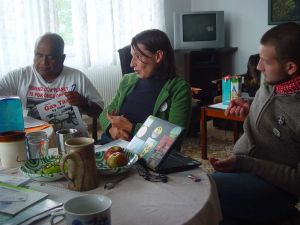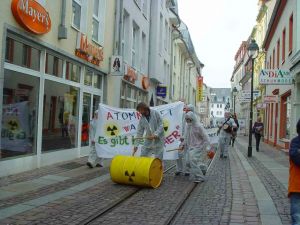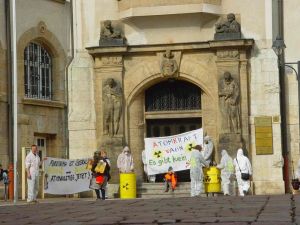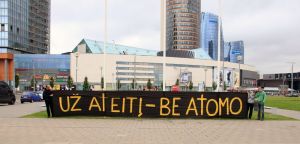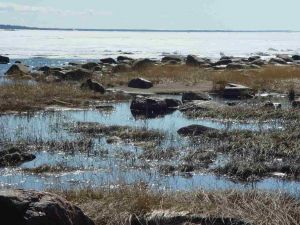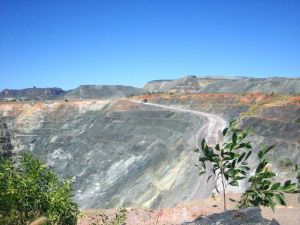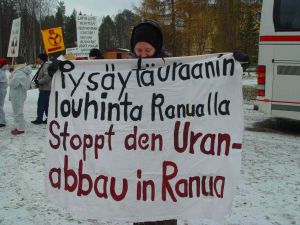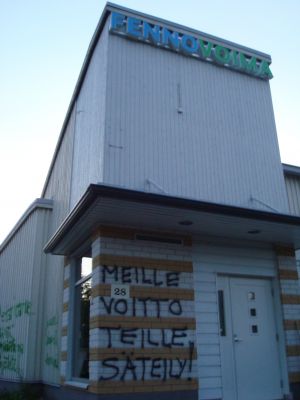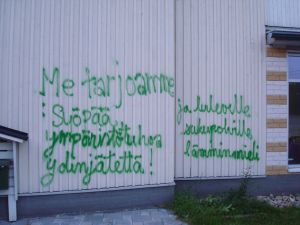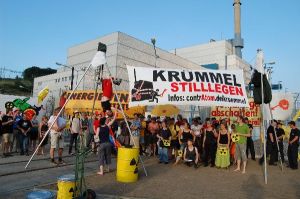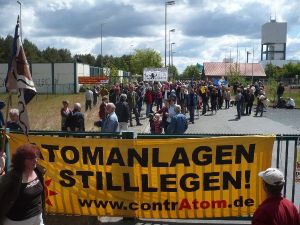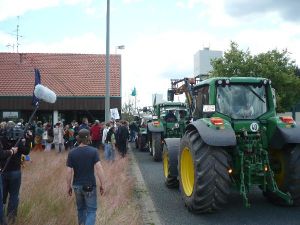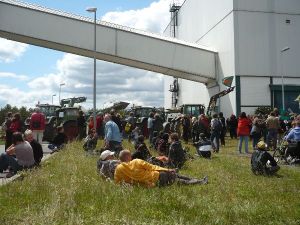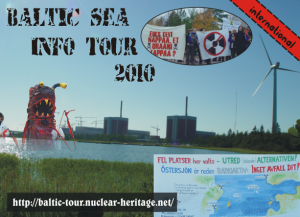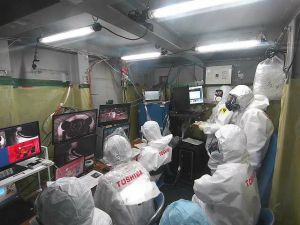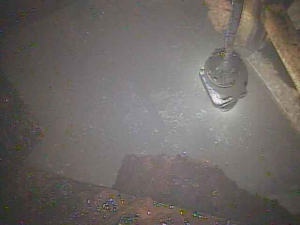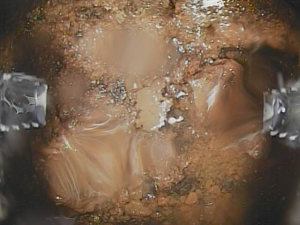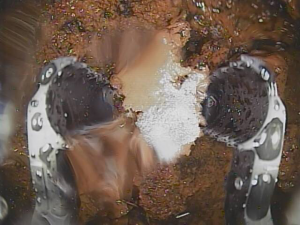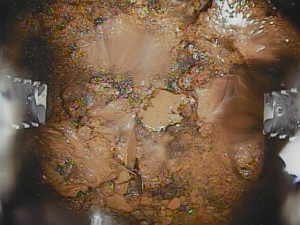Nuclear Heritage Network
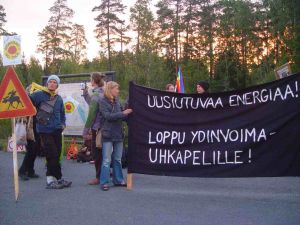 Access roads to the Olkiluoto NPP (FIN) successfully blockaded several times |
 Launching the anti-nuclear art project "25" in Murmansk (RUS) |
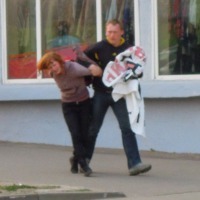 Special police forces arrested 12 activists after an international anti-nuclear action in Minsk (BY) on April 25 |
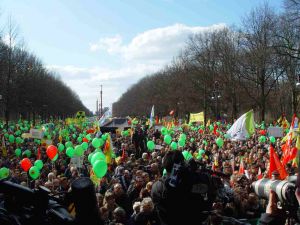 Fukushima demonstration: 250,000 protested in four German cities, 120,000 of them in Berlin |
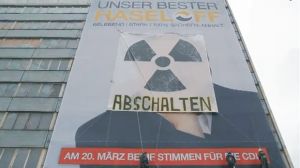 Action in Magdeburg (D): "Shut down" added to huge election banner of ruling pro-nuclear party (video) |
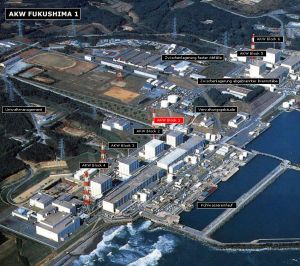 Overview of the nuclear facilities at the site of the NPP Fukushima I - provided by Spiegel Online |
 60,000 protested against nuclear power on 12/3/11 in a human chain between Stuttgart and NPP Neckarwestheim (D) |
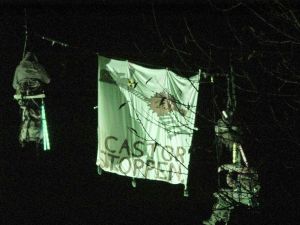 Climbing activists blockade the Castor transport at Morschen (close to Kassel, Hesse, D) |
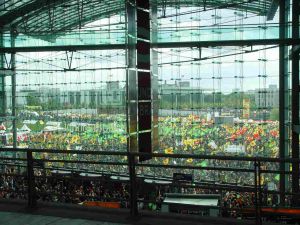 100,000 protested in Berlin against atomic power |
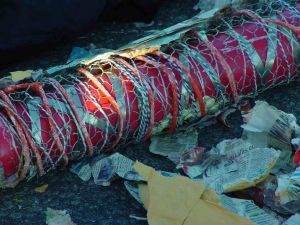 Olkiluoto successfully blockaded in Finland on August 28, 2010 |
 Renewables beating nuclear power in Riga! |
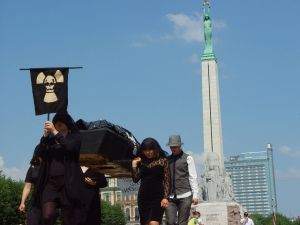 Anti-nuclear funeral action group in front of the statue of liberty in Riga |
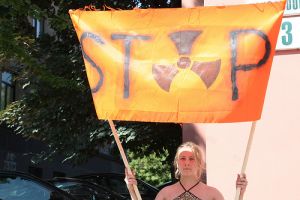 Actions against NPP developments in front of the Polish, Swedish and Finnish embassies in Vilnius |
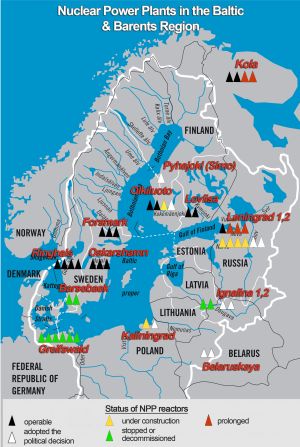 Nuclear power plants around the Baltic Sea |
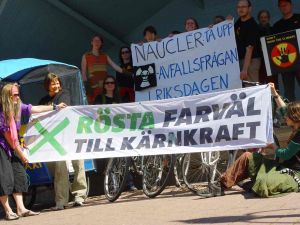 Action in Mariehamn |
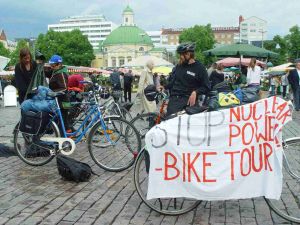 Anti-nuclear Biketour has started in Turku |
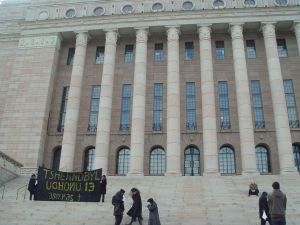 Chernobyl Day action of Women Against Nuclear Power in Helsinki, Parliament |
File:Baltic Tour Flyer Page 1.png Baltic Sea Info Tour - getting started! |
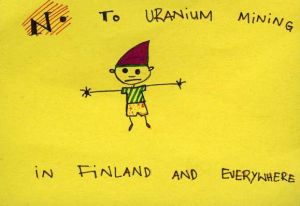 New postcards against uranium mining in Finland in several languages... |
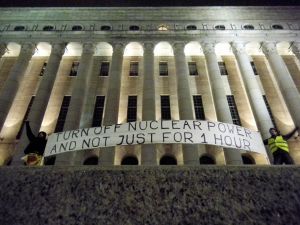 Helsinki (FIN): Action in context of an international network meeting |
 Protests against uranium mining in Finland |
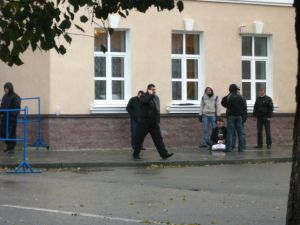 Russian anti-nuclear campaigner Andrey Ozharovskiy being arrested in Belarus while the hearings for the Environment Impact Assessment of the planned new NPP took place |
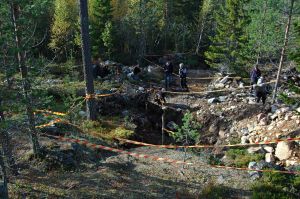 Activists examine the area of Areva's drilling activities |
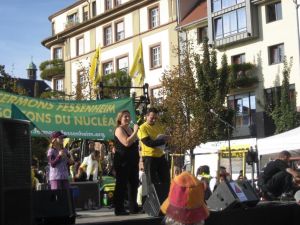 Shut down Fessenheim rally: Kerstin Rudek (BI Lüchow-Dannenberg) and Jean-Yvon Landrac (Sortir du nucléaire) |
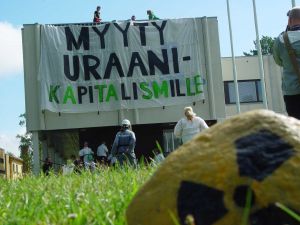 Nuclear Climate Camp: City Hall of Simo - "Sold to the Uranium Capitalism" |
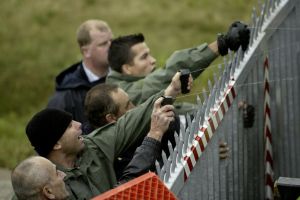 Police violance: Pepper spray against protesters from the Gorleben Treck in Morsleben (Photo: Andreas Conradt / PubliXviewinG) |
 About 50,000 people demonstrated in Berlin against nuclear power (Photo: Andreas Conradt / PubliXviewinG) |
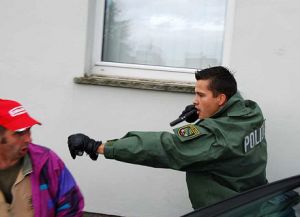 Policeman attacks a farmer in Morsleben with firearm |
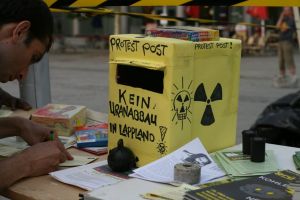 Ranua Rescue Action Day: post box for creative protest |
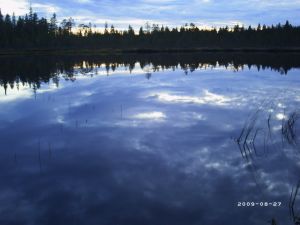 Near the Finnish Community of Ranua a camp has been set up to monitor Areva's mining activities |
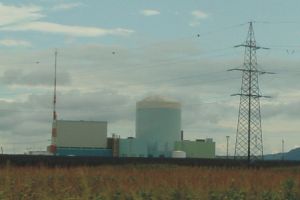 Slovene NPP Krško - visited during the International Network Meeting in Ljubljana |
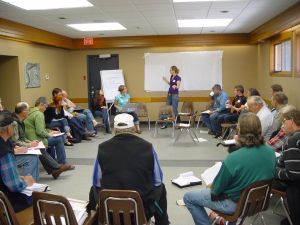 Canada: Tar Sands, new NPP plans & more concerned people at the Land Stewards Gathering in Edmonton |
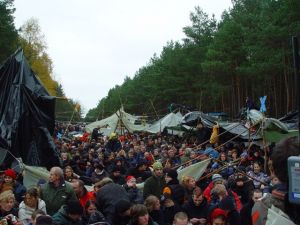 Castor: Mass blockade of thousands of people with tents, tarpaulins and tractors |
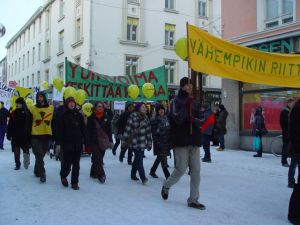 Demonstration in Oulu against new NPPs and Uranium mining in Finland |
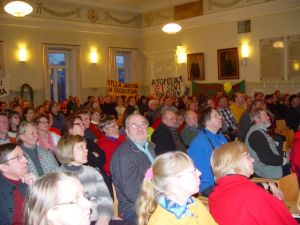 Oulu Demonstration: Lectures after the demonstration... |
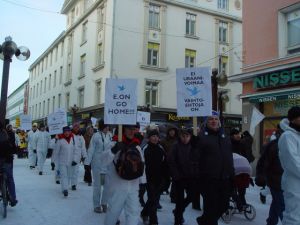 Oulu Demonstration: Protest against EONs' new NPP plans in Finland |
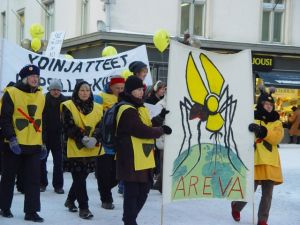 Oulu Demonstration: Protest Against Areva's Uranium mining plans in Finland |
FUKUSHIMA DISASTER | UPCOMING EVENTS | NEW ARTICLES | NEWS | COMMUNICATION | ACTIVITIES | LINKS | PROMOTION
We want to connect anti-nuclear activists worldwide, provide information regarding nuclear issues and anti-nuclear activities in many countries and develop projects and campaigns. This website offers you background information, images, press releases, material and much more. Take some time to explore the Nuclear Heritage Network!
This website is based on the MediaWiki software (similar to Wikipedia) - this means you can edit pages, add your anti-nuclear contents or publish flyers. Help to extend the contents of our webpage, make translations or corrections and add new topics.
The Nuclear Heritage Network is more than this website. Twice a year we organize international network meetings, there are several mailing lists for communication and several international cooperation projects. We are also developing informational material on local topics in different languages for international use.
Nuclear Disaster in Japan
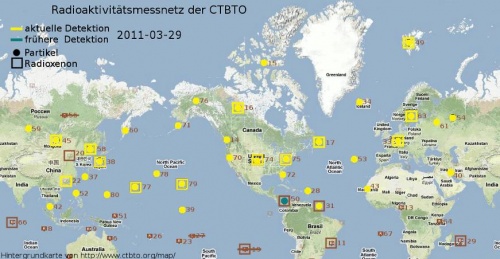
As a result of a 14 meter tsunami wave[1][2] and a 9.0-magnitudes earthquake the Fukushima I Daiichi[3] atomic power plant in Japan experienced a nuclear catastrophe of a level higher than the 1979 Harrisburg accident, maybe turning out to become even worse than the 1986 Chernobyl catastrophe[4][5][6][7][8][9][10][11] including several explosions, fires, failing cooling systems,[12] meltdown of fuel elements and uncontrolled releases of high amounts of radioactivity[9] since March 11, 2011. Unit 1 exploded on March 12, 2011 at 6.36 AM UTC[13][14], unit 3 exploded two days later on March 14 at 2.01 AM UTC[15][16][17] and eventually also unit 2 blasted in the following night (14/3/11 9.10 PM UTC) damaging the reactor core and as officially confirmed releasing serious amounts of radiation[18][19]. Also unit 4 which had all nuclear fuel in the reactors spent fuel pool exploded March 14 at approximately 9 PM UTC[20].
Another 6.5 earthquake occured on March 28 160 kilometers from Fukushima I Daiichi[21]. An even stronger quake at 7.1 having its epicenter in distance of 120 kilometers to the Fukushima NPP took place April 7 causing the emergency workers at Fukushima I Daiichi again to be evacuated from the site, while two of three emergency power systems failed due to the aftershock at the Onagawa NPP[22][23]. A nuclear meltdown occured in unit 2[24], the Japanese government ended up to admit on March 28[25] - "The battle to save the four crippled reactors is lost", Japanese officials conceded March 31[24]. Operator TEPCO informed not to be able to guarantee preventing another meltdown[21]. The IAEA informed on March 31 about a possibility of a "recriticality" at the Fukushima plant, which means a nuclear chain reaction would resume leading to more radiation releases, although the reactors were automatically shut down on March 11 due to the quake[12]. April 12 NISA classified the Fukushima disaster to INES level 7[5][4].
"Fukushima means 'fortunate island' but the region's luck melted down along with the reactors at the Fukushima Daiichi nuclear plant following the earthquake and tsunami."[26]
CONTAINMENT | MOX | STATUS | ADDITIONAL ACCIDENTS | HEALTH | RESCUE ACTIVITIES | CAUSES | REACTIONS | LINKS | LATEST NEWS
The atomic disaster in Fukushima has been classified an INES 7 accident by the Japanese Nuclear and Industrial Safety Agency (NISA) as demanded by Greenpeace and experts already long time before. Japan declared an "atomic power emergency" on March 11. Thousands of residents have been evacuated from the 20 kilometer zone around the stricken nuclear power plant. The disaster was caused by an interaction of a heavy earthquake of magnitude 9 destroying supplies and parts of buildings and a tsunami wave about 14 meters high destroying the emergency power generators. The emergency power batteries bridged a couple of hours, before the cooling systems failed totally. Exposed without any or enough water the fuel rods of one or more reactors melted down at up to 2,700 degrees.
As a result of the earthquake and the explosions in four reactors of the nuclear Daiichi complex several reactors' containment was damaged. A particular threat in this catastrophe is unit 3 of the NPP, a MOX fueled reactor containing large amounts of plutonium which is of special health risk due to its high energy radiation as a substantial alpha emitter and due to its specific toxic characteristics as well as because of its long-term halftime of more than 24,000 years.
New threats of catastrophic extend at the Daiichi units are uncovered every few days - often by foreign experts, while Japanese authorities and the operator of the blasted reactors yet downplay the impacts of the catastrophe and in many cases would not concede the incidents before being published by other hand. By April 9, some of these possible threats uncovered by a US newspaper are: a collapse of containment structures due to the weight of tons of water poured for cooling onto the reactors; a molten core could melt through the bottom of the pressure vessel; a new hydrogen explosion destroying the containment and releasing large amounts of high radioactive substances; increased risks caused by seawater that had been used in the emergency cooling operations.
A fire occured close to block 4 on April 4 and was quickly extinguished after it had been recognized.
INES Catastrophe Level Dispute
Since April 12, the Fukushima disaster is classified at INES level 7 by the Japanese Nuclear and Industrial Safety Agency (NISA)[5] - the highest possible catastrophe classification of the IAEA[4][27]. Until this day both NISA and the International Atomic Energy Agency (IAEA) had refused to raise the INES level from 5 to the highest possible category, while since March 25 Greenpeace demanded the IAEA to classify Fukushima as an INES level 7 accident like Chernobyl 1986 based on a study[28] they had published[29]. Several other nations' radiation protection authorities had already classified it to level 6[30]. Japan was reported on March 31 to be considering to increase the accident level to INES 6[9].
Atomic Power Emergency Declared
An atomic power emergency had been declared by the Japanese government on March 11[1], while up to 300,000 residents (other sources talk about "over 200,000"[31][32] or 77,000 [33]) had been evacuated in a zone of 20 kilometers around Fukushima I Daiichi and Fukushima II Daini[3][18]. Several emergency power generators failed supplying the emergency cooling systems with electricity[30]. The authorities confirmed the release of radioactive elements such as cesium and iodine[34]. Also a fire occured on March 15 at 0.40 AM UTC at unit 4[19] - a reactor unit that had not even been in operation when the tsunami hit the Japanese coast on March 11.
Hidehiko Nishiyama, spokesman with NISA explained April 3: "It would take a few months until we finally get things under control and have a better idea about the future. - We'll face a crucial turning point within the next few months, but that is not the end."[6].
Nuclear Meltdowns Conceded
Independent experts say that a nuclear meltdown must have happened[35][36][37]. "The cores of the three reactors[38] are believed to have partially melted", the Japanese news agency Kyodo reported on March 14[19][39]. According to the German news "Tagesschau" Japanese officials also confirmed a nuclear meltdown in Fukushima[35]. This had been confirmed by a statement of Chief Secretary Yukio Edano on Sunday saying that at least one nuclear meltdown occured [30], eventually confirmed by the Japanese government on March 28: a nuclear meltdown of fuel elements - maybe melting through the bottom of its containment vessel and on to a concrete floor[40][24] - happened at unit 2[24] already shortly after the earthquake and tsunami of March 11[41]. Japanese officials called it a "partial meltdown"[42]. This seems not to be correct due to the limited volume and high temperatures in the core[43] as explained in section Causes Of The Disaster. The operator had indicated already March 15 that a meltdown could have happened as the fuel rods had been damaged[19]. GE's head of safety research for this type of reactor told The Guardian newspaper he would believe the reactor core of unit 2 to already have melted through the bottom of the pressure vessel and at least some of it would have reached the concrete floor beneath[12].
Earlier Edano had stated also a nuclear meltdown in reactor 3 of Fukushima 1 to be "possible"[30]. This was again topic of concern on March 26, while scientist Sebastian Pflugbeil suspects the meltdown to happen already for several days due to the high releases of radiation[44]. At the latest since March 31, 2011 we have to talk about "three raging meltdowns in progress"[9]. NISA said on March 12 that the explosion at the Fukushima Daiichi No. 1 nuclear plant could only have been caused by a meltdown of the reactor core[45].
Nuclear engineer Arnold Gundersen, who worked for years in leading position for the atomic industry, on April 7 said in a broadcasting a nuclear meltdown in the spent fuel ponds at unit 4 is going[46]. The fuel is totally exposed to the air, while it should be covered by five meters of water, he explained[46]. According to an internal Areva paper on Fukushima, on fresh air a core meltdown would occur, leading to a large release of radiation due to a lack of retention of fission products[46].
Only in March 2015 TEPCO was reported to have admitted the complete meltdown of the nuclear fuel rods (estimated 125 tons of uranium dioxide, zirconium, steel, boron carbide, and inconel - other source: 150 tons of very heavy, intensely radioactive material, that has melted like candle wax and simply dripped away[47]) four years ago at unit 1 of Fukushima Daiichi. This was after muon tomography scans confirmed what had been suggested by different sources for years. Now, according to the report, the highly radioactive slag is believed to fill the bottom of the Pressure Containment Vessel (PCV). The water level inside the Reactor Pressure Vessel (RPV) had dropped starting within hours of the tsunami with the fuel melting as a consequence. First TEPCO had denied a melt-through of the core - molten corium completely flowing through the RPV into the PCV, before maybe being stopped by the several meters of concrete within the base, but later stated it was a most likely scenario. Independent expert Gordon Edwards summarizes that the reactor vessel is devoid of fuel as "it has all melted or dripped through the bottom of the reactor vessel, and it is still unknown where it has all gone to"; he also suggested a possible flow further through the floor of the reactor into the ground water below could have occured[47].[48]
In an interview published April 2, Greenpeace expert Wolfgang Sadik expressed concerns about the officials searching for zirconium outside the reactors - which actually means: they are looking for traces of the melted reactor core[49].
An internal Areva paper on the Fukushima disaster reported meltdowns at temperatures up to 2,700 degrees (other source: 2,800 degrees[47])[46].
The hydrogen building up in several units (especially unit 1) is a symptom of damaged fuel rods in the cores of the reactors[2].
Unit 2 is believed to have gone back into criticality with a nuclear chain reaction coming and going[6]. "Since unit two is showing signs of fission happening, the chances of something more catastrophic happening at that site are increasing," Mary Olson, director of the Southeast Office of the Nuclear Information and Resource Service (NIRS) explained in an interview on April 8[6].
Extension Of The Evacuation Zone
First, an area of 3 kilometers had been evacuated on Friday, March 11. Later it was enlarged to a 10 km evacuation zone and then to 20 km, while residents of the 20-30 km zone were advized not to leave their houses[50][51][1]. On the very first day a BBC reporter spoke about a prohibition zone of 60 kilometers.[52] March 25, Japan's government urged the residents of the 20-30 km zone to leave the area, too[53][54][55][24]. More than 10,000 people are still in the area, NHK reported[56] Japan's government considers to recommend residents outside the 30 kilometer zone to leave the area, media reported on April 8[22].
CNN reported April 7 the government only to "consider" to enlarge the evacuation zone and chief Secretary Edano to add there wouldn't be a timetable for making this decision yet[50]. A new safety category for long-term exposure would be in discussion to protect citizens against the impacts of accumulated radiation doses[50]. This would effectively extend the evacuation zone, a government's official said April 7[50]. The neighbourhoods by the Fukushima NPP will have to remain empty "for the long term", chief Secretary Edano said April 1[24]. Eventually on April 11 the evacuation zone was expanded to 30 km due to the discussed health risk of long-term radiation exposure including the following areas: Katsurao Village, Namie Town, Iitate Village and some parts of Kawamata Town and Minami Soma City[57]. Other areas in the 30 km zone will be evacuated at the latest after one month, while residents within this radius are told to be prepared for emergency evacuation, Chief Cabinet Secretary Edano said[57]. In contradiction to a ruling by Japan's government imposing a no-entry zone prohibiting residents from remaining within a 20-kilometer radius of the Fukushima Daiichi nuclear power plant beginning as of 21th April[58], the authorities permitted residents of the Kawauchi village inside the 20 kilometer zone to return to their homes for a limited time of some hours to take personal possessions out of the prohibited area, RT Moscow reported May 10[59].
On March 24, 23 members of Japan’s Parliament signed a statement urging a larger evacuation zone [60], while on March 28 some 168 citizens organizations in Japan submitted a petition to the government to enlarge the evacuation area[24]. The United States suggested the evacution zone to be enlarged up to 80 kilometers, and recommended US citizens not to stay there[24].
Fukushima NPP To Be Scrapped - Compensation Claims On TEPCO
TEPCO announced to scrap the four exploded Daiichi reactors, while chief Secretary Edano recommended to decommission all six units of the nuclear power plant[61][24]. The newspaper Mainichi reported the government's plan to give TEPCO an injection of money acquiring up to 50 % shares of the company[62]. Fukushima's operator's stock exchange index had been fallen by 80 % within some three weeks since the beginning of the atomic disaster[62][38]. TEPCO will possibly be asked for tens of billions of dollars compensation due to the catastrophe[62][63] - the biggest size of claims in Japan's history[64]. Latest calculations by analysts on behalf of the Worldwatch Institute estimated costs of $ 100 billions or more[38]. April 6 the Los Angeles Times reported TEPCO to have announced the day before to give "condolence payments" totaling about $2,000,000 to those residents who had to leave their homes due to the evacuation in connection with the atomic catastrophe at Fukushima[63].
New Threats To The Wrecked Reactors
Tons of water pumped into the reactors to cool the nuclear fuel could cause a collapse or serious damage of the containment structures especially in case of aftershocks as the March 11 earthquake could have compromised the stability of them, US experts in connection to a April 5 uncovered confidential paper of the US nuclear safety authority[65]. Partly workers had put hundreds of tons of water a day into the reactors[2].
In a statement of April 1, 16 Japanese experts on nuclear power engineering, nuclear physics and radiology, said they could not rule out the possibility that a molten core melts a weak part of a pressure vessel and enters a containment vessel. Another possible threat they phrased was another hydrogen explosion destroying a containment vessel, causing a severe radioactive contamination of land and sea. That release could make uninhabitable larger areas than just the current evacuation zone. The current activities to cool the reactors 1-3 would not be capable to completely cool down the molten nuclear fuel to prevent it to burst through the bottom of pressure vessels.[66]
Governmental Reactions To The Disaster
In response to the catastrophe Japan's government issued tougher regulations for emergency power at nuclear power plants including the requirement to provide two instead of just one diesel generators as backup for each reactor unit[2].
Damages of the containment
On Saturday March 12 the Japanese authorities claimed the reactor pressure vessel of unit 1 of the Daiichi NPP wouldn't have been damaged. But this is in conflict with the officially confirmed releases of cesium. The evening before the first explosion the authorities already had claimed there would not be any danger of radioactivity releases. On the contrary, first independent meassurements of radiation showed a serious radioactivity even in a certain distance to the crashed reactor units[67].
A suspected breach in the core at one reactor at a stricken Fukushima nuclear plant could mean more serious radioactive contamination, Japanese officials revealed Friday - a situation the prime minister called "very grave and serious", Assiocated Press reported on March 25[68].
Seawater Used For Cooling Increases Risk Of Additional Incidents
Japan's defense ministry said that US-American officials had expressed grave concern that the saltwater could cause equipment to seize up and corrode, making resolution of the situation even more difficult[53]. A confidential paper dated to March 26 of the US Nuclear Regulatory Commission based on information of US engineers sent to Japan to support the emergency activities at Fukushima expresses concerns about an "array of new threats" at the Fukushima NPP, the New York Times uncovered April 5 including assessments about the possibility of new explosions due to the release of hydrogen and oxygen from seawater pumped into the reactors in order to cool the core down[65]. These blasts could lead to more serious releases of radiactivity destroying those barriers keeping it yet inside[65]. The water flow in unit 1 is "severely restricted and likely blocked due to slumping fuel and salt from seawater used to cool the wrecked reactors probably blocking the circulation pathways, the paper describes[65]. The US engineers also suspect fragments or particles of nuclear fuel coming from the spent fuel pools above the reactors were blown "up to one mile from the units"[65]. This would mean the spent fuel ponds have been much more seriously damaged by the earlier hydrogen explosions than admitted to public by now[65].
Nuclear Inventory Of Fukushima Higher Than Chernobyl
According to the German news magazine Spiegel altogether more than 2,500 tons of uranium and plutonium are situated at Fukushima[69]. Bellona informed about 1,760 tons stored in Fukushima stressing the fact that this potential threat is even higher than the Chernobyl catastrophe, where 180 tons were kept[70], facts confirmed by the Austrian Central Institute for Meteorology and Geodynamics on March 24[24] and by 16 Japanese scientists in a statement of April 1 saying units 1-3 contain much more radioactive substances than the Chernobyl NPP did[66]. A report from the New York Academy of Sciences testified 985,000 people to have died between 1986-2004 due to the Chernobyl disaster[24]. April 8, the International Physicians for the Prevention of Nuclear War (IPPNW) launched a study showing 600 million people in Europe have been affected by the Chernobyl disaster.[71].
A TEPCO spokesman informed April 12 that the total amount of radiation released at Fukushima may exceed Chernobyl's[5]. Prof. Sebastian Pflugbeil, president of the Gesellschaft für Strahlenschutz, stated in an interview to the German television ARD on April 12, that the nuclear meltdown of 4 reactors in NPP Fukushima Daiichi is worse than the reactor explosion and nuclear meltdown of Chernobyl, because in Fukushima there is more reactor inventory of uranium and plutonium involved[72]. He is concerned, that the local area around Fukushima will be higher radioactive contaminated than in Chernobyl[72].
Collapsed MOX Reactor Is Particular Risk
Around 9 PM UTC Saturday March 12 evening Reuters informed about Fukushima I Daiichi unit 3 that "the emergency cooling system is no longer functioning (...) as an official of the Japan Nuclear and Industrial Safety Agency told a news conference"[73]. "This is of particular concern since, unlike all of the other reactors in trouble, Unit 3 has been using plutonium-based MOX (mixed oxide) fuel[9] since September 10, 2010. Plutonium is the most toxic chemical known to science[9]. MOX fuel elements contain 7-8% of it[74]. Consequences of an accident at a MOX-powered reactor would be even more severe than at a more typical uranium-powered reactor[75]", says the Nuclear Information and Resource Service[60] On March 13 the chief Cabinet secretary of Japan's government informed that an explosion at unit 3 of Fukushima 1 is possible to occur, but that they wouldn't expect a meltdown to happen[76][77] (however they want to be sure about that after the last days' experiences...). Several attempts to cool the reactor core failed until the late evening of Sunday[30], it eventually exploded Monday morning at 2.01 AM UTC[78][79]. NIRS believes there are now multiple meltdowns in progress along with significant releases from irradiated fuel pools[60].
As the officially admitted radiation rate of 20 rems/hour (10,000 times above normal) affecting three workers at unit 3 on March 23 would not be high enough to cause the burns that were reported on them, there is suspicion that the rates were even higher. Radioactive elements were found in the water that are not normally found in reactor cooling water. This has led to new open speculation among government and utility officials that the core of unit 3 has been breached[9] and primary containment has failed (most observers have suggested this for several days, NIRS said)[60]. The possibility of an even more severe environmental contamination was announced by Japanese officials on March 25 due to a suspected fracture of the unit 3 reactor core, a NISA spokesman was quoted by AP[80]. Since March 11 the operator is struggling to cool the unit containing 170 tons of MOX fuel[80]. The damage could have been caused by the hydrogen explosion of March 14 blowing up the outer containment[80]. High-level radiation is suspected to be leaking from the number three reactor core[81].
As reported on March 28, plutonium isotopes 238, 239 and 240 have been found[82][69] by TEPCO in the soil at five locations at Fukushima I Daiichi[70]. One sample of plutonium-238, according to TEPCO, was measured at 0.54 Bq/kg of soil, and the mix of plutonium-239 and -240 in two other samples measured 1.2 Bq/kg[70]. It must come from the fuel rods, the NPP operator suspects and chief Secreatry of the Japanese cabinet Edano agrees adding this would confirm a fuel meltdown has occured[70]. In case it reachs the human body it can cause serious health damages - already small quantities can lead to high radiation affects as plutonium can be accumulated in bones and liver causing cancer[69].[83] The breach of the containment of the reactor must be serious, as plutonium is a heavy element not being able to easily escape, a NISA speaker explained[69]. Already March 21 and 22 TEPCO had detected plutonium, but told these findings not before March 28[69]. According to former boss of the German atomic energy authority, Wolfgang Renneberg, the plutonium contained in unit 3 of Fukushima could become a deadly threat if it would be blown out of the reactor for instance by an explosion[69]. In this case it would be spread widely and possibly be breathed in by humans[69]. It could also end up in the food chain and eventually also in the human body, if plutonium would be washed into the ocean, Renneberg said[69].
Status of the affected facilities
- Fukushima 1 unit 1: wastewater samples from the basements of the turbine buildings and tunnels show higly increased radioactivity, TEPCO informed: 400 Bq/cm³ of iodine-131 and 53 Bq/cm³ of cesium-134 - 6 times and 38 times higher than the previous week's readings (13/4/11)[84]
- gauges in the reactor pressure vessel showed the highest radiation readings of 68,8 Sv/h since reestablishment of this measurement after the earthquake on March 11th, 2011 (8/4/11)[85]
- nitrogen injections to the reactor have been started (7/4/11)[50][86][87]
- about 70 % of the 400 fuel rods in the core are damaged, TEPCO said; nitrogen injections to the reactor have been started (7/4/11)[66][50][88][87]
- the possibility of an explosion of stored-up hydrogen has been stated by TEPCO, while NISA said there was no immediate chance of an explosion; TEPCO wants to start nitrogen injection this evening to prevent a hydrogen explosion (6/4/11)[89][90][91][87]
- leaks in the containment have been officially admitted by the authorities (29/3/11)[7]
- INES level 5; fuel rods partly exposed; reactor core seems to be damaged; radiation in water in the turbine building 10,000 times the normal level containing cesium-137 (27/3/11)[92]
- water flow "is severely restricted and likely blocked" due to slumping fuel and salt from seawater blocking it; probably no water anymore is inside the core itself anymore (26/3/11)[65]
- leaks of the vessel's shielding reactor cores suspected by IAEA officials (26/3/11)[93]
- high radiation releases have been reported; highly radioactive water has been detected at the turbine buildings; a "cold shutdown" of the plant is expected to take at least one more month (25/3/11)[29][81]
- Steam was seen coming from Units 1 through 4 today, in some cases large amounts - the steam is carrying radiation into the air (24/3/11)[60]
- high temperatures reported, dashing hopes that reestablishing power to the entire plant on Tuesday would quickly help stabilize it (23/3/11)[94]
- irregular but extremely high heat levels appear according to CNN infrared pictures - this could be of major concern (21/3/11)[60]
- The water level is such low that measurement instruments couldn't be recorded clearly anymore as the Japanese nuclear authority NISA found out (18/3/11)[95]
- The outer building is damaged and it is presumed that there was a partial meltdown. At least small amounts of radioactivity have been vented (16/3/11)[96]
- hydrogen explosion destroys upper part of the reactor (12/3/11 6.36 AM UTC)[13][97]
- Fukushima 1 unit 2: TEPCO informed about detections of 610 Bq/cm³ of iodine-131 and 7.9 Bq/cm³ of cesium-134 - 17 times and 8 times higher than the previous week's readings (13/4/11)[84]
- some 8 tons of water are poured every hour to cool the reactor (7/4/11)[50]
- a portion of the reactors core seems to have fallen from the pressure vessel to the bottom of its containment drywell, NRC indicated (6/4/11)[87]
- some 30 % of the fuel rods in the core are believed to have been severely damaged (6/4/11)[66][50][88][87]
- TEPCO announced to eventually have sealed the crack in the reactor using "water glass" (sodium silicate) acting as cement (6/4/11)[89][63][90][98]
- a 20 cm long crack in a reactor wall has been found leaking highly radiactive water (above 1 Sv/h) to the reactor basement (2/4/11)[49]
- TEPCO informed water in the trench to contain radioactivity above 1 Sv/h (31/3/11)[99]
- leaks in the containment have been officially admitted by the authorities (29/3/11)[7]
- radiation levels 100,000 times normal detected (1,000 mSv/h[40]), said TEPCO, while the Japanese government confirmed a meltdown occured already shortly after the March 11 earthquakes (28/3/11)[21]
- radiation detected by TEPCO in the reactor exceeded 1 Sv/h - a possibly lethal dose; the reactor was evacuated temporarely (27/3/11)[92]
- INES level 5; fuel rods partly exposed; reactor core seems to be damaged; containment seems to be damaged; radiation in water in the turbine building 10 million times the normal level containing iodine-134 (27/3/11)[92]
- leaks of the vessel's shielding reactor cores suspected by IAEA officials (26/3/11)[93]
- highly radioactive water has been detected at the turbine buildings; a "cold shutdown" of the plant is expected to take at least one more month (25/3/11)[81]
- high radiation reported, dashing hopes that reestablishing power to the entire plant on Tuesday would quickly help stabilize it (23/3/11)[94]
- analysis of infrared pictures published by CNN indicates there may be no water at all (21/3/11)[60]
- rescue teams are pumping sea water into the fuel ponds; the reactor is connected to the emergency electricity grid again; the containment is damaged; radiation has leaked (20/3/11)[100]
- 1.4 m of the fuel rods are exposed (17/3/11 11 PM UTC)[95]
- primary containment is believed to be significantly breached (16/3/11 2 PM UTC)[60]
- there has been an explosion; there is speculation that this explosion has damaged the primary containment(14/3/11)[60]
- fears of a partial meltdown as the fuel elements were several times totally exposed and thus cooling failed (14/3/11)[18]
- no cooling capability anymore (12/3/11)[60]
- Fukushima 1 unit 3: 25 % of the fuel rods in the core are believed to have been severely damaged (6/4/11)[66][50][88][87]
- leaks in the containment have been officially admitted by the authorities (29/3/11)[7]
- INES level 5; fuel rods partly exposed; pressure vessel as well as the cooling pond seems to be damaged (27/3/11)[92]
- data indicated a leak at the reactor, IAEA officials said (26/3/11)[93]
- Japanese officials have expressed alarm over a possible fracture of the reactor core; high-level radiation is suspected to be leaking (25/3/11)[80][81]
- NISA suspects the core to be damaged[54] and radioactive water to leak through the containment vessel as water in the turbine room was "about 10,000 times the level[54] of radiation found in the coolant inside a reactor"[53]; a nuclear meltdown is said to be likely[29] (25/3/11)
- dark smoke forced officials to evacuate the facility (23/3/11)[94][101]
- substantial amounts of smoke, workers were temporarily evacuated (21/3/11)[60]
- irregular but extremely high heat levels appear according to CNN infrared pictures - this could be of major concern (21/3/11)[60]
- rescue teams spraying water onto unit 3 again, after 13 hours of water cannon action could not prevent the increase of pressure by Sunday (20/3/11)[100]
- the condition of the fuel pools appears to remain more serious (19/3/11 2.30 PM UTC)[60]
- 2.3 m of the fuel rods are exposed (17/3/11 11 PM UTC)[95]
- the fuel pool might also be losing water and could soon be in the same condition as at unit 4 (16/3/2011)[102]
- serious hydrogen explosion damaging the building (14/3/11)[92]
- cooling systems failed (13/3/11)[92]
- Fukushima 1 unit 4: a fire in a box containing batteries in a building near reactor was discovered at about 6.38 AM local time and was put out seven minutes later, TEPCO informed (12/4/11)[4]
- INES level 3; cooling pond possibly damaged and indication for overheating (27/3/11)[92]
- NRC report suggests the earlier hydrogen explosion could have spilled much radioactive material into the environment - "a major source term release" (26/3/11)[65]
- smoke or steam visible (21/3/11)[60]
- after unsuccessful attempts to cool the reactor with ten water cannons of the Japanese military and a vehicle of the US military, rescue teams started again spraying water onto the damaged reactor (20/3/11)[100]
- the condition of the fuel pools appears to remain more serious (19/3/11 2.30 PM UTC)[60]
- US NRC Chairman Greg Jazcko told a Congressional committee this afternoon that the Unit 4 fuel pool has no water and is releasing massive amounts of radiation (16/3/11 8.30 PM UTC)[60]; commission representatives in Tokyo and TEPCO confirmed that the pool at No. 4 was empty (18/3/11)[102][95]; NRC people were on the site saying that the fuel pool is without water and that the released radiation is lethal in a short period of time (17/3/11 9 PM UTC)[60]
- flames appeared; it is impossible to go near the fire since the radiation is so high (15/3/11 8.45 PM UTC)[60]
- fire in the irradiated fuel pool and hydrogen explosion; two big holes in the outer wall; serious damage of the building (15/3/11 12.15 PM UTC)[60][92]
- TEPCO announced an explosion occured in unit 4 at approximately 9 PM UTC (14/3/11)[20]
- Fukushima 1 unit 5: Japanese authorities announced to have stabilized the reactor, after the cooling systems were brought into operation again (20/3/11)[100]
- TEPCO has cut holes in the roofs of the containment building in an effort to remove building pressure and prevent explosions such as those that severely damaged Units 1, 3 and 4. This means some radiation is certainly being released through these holes (19/3/11 2.30 PM UTC)[60]
- offcials said they had experienced a slight rise in temperature, while the operator says the emergency power supplies have been restored (18/3/11)[102][95]
- Fukushima 1 unit 6: Japanese authorities announced to have stabilized the reactor, after the cooling systems were brought into operation again (20/3/11)[100]
- TEPCO has cut holes in the roofs of the containment building in an effort to remove building pressure and prevent explosions such as those that severely damaged Units 1, 3 and 4. This means some radiation is certainly being released through these holes (19/3/11 2.30 PM UTC)[60]
- offcials said they had experienced a slight rise in temperature, while the operator says the emergency power supplies have been restored (18/3/11)[102][95]
Connected additional accidents in other atomic facilities
Several other nuclear Japanese facilities are faced to serious safety issues as a result of the tsunami and earthquakes: the reprocessing unit Rokkasho (difficulties with cooling systems), the NPP Fukushima 2 Daini (fire, failing cooling systems - atomic power emergency declared), the NPP Tokai (two of three emergency power generators failed) and the NPP Onagawa (fire, leakage - atomic power emergency declared)[34][30].
As a result of a new heavy 7.2 earthquake, two of three power supplies failed at the Onagawa NPP, NISA informed April 7[23]. A small amount of radioactively contaminated water splashed from fuel pool at all three reactors, operator Tohoku Electric Power Company informed[22][103]. At one unit, the company said, about four liters of middle radioactive water were spilling from the spent fuel pool[104]. Besides, leaks were found at eight (other source: five[103]) spots at the plant[22]. Although the power plant has been shut down after the earthquake on March 11[103][104], the fuel still needs to be cooled[22]. Yet the emergency power seems to be ensured, but due to the aftershock cooling was interrupted briefly[22]. The blowout panels, a device at the turbine building intended to controll the pressure, was also damaged by the quake[103][22]. At the Higashidori NPP and at the Rokkasho reprocessing unit the external electricity supply was interrupted, but the emergency power systems worked, Kyodo reported[22].
Health Impacts Of The Catastrophe
"News reports mention Iodine-131 and Cesium-137, not because they are the only radioactive elements discharged from the stricken reactors in Fukushima, but because they are the easiest to detect and measure," Physicians for Global Survival explained in a press release April 1[105]. What is measured usually is the gamma radiation iodine produces itself and cesium produces it through its decay product barium-137[105]. Alpha and beta emitters are much more difficult to detect[105]. It is important to be aware that the isotopes mentioned in the publications of TEPCO or NISA are not the only ones emitted from Fukushima[105].
Tiny amounts of breathed in plutonium isotops are capable of causing lung cancer[7]. Plutonium is a substantial alpha emitter, some of its isotopes also radiate beta rays, while the gamma radiation is on an insignificant level[106]. Unfortunately, neither the usual Geiger counter[75] nor the official radiation measuring systems are able to detect plutonium. Thus, the published data of radiation detection doesn't reflect the actual radioactivity threat[106]. The isotope plutonium-239 is generated in considerable amounts in nuclear power plants and has a halftime of about 24,000 years[106].
According to the US Department of Energy, no level of radiation is so low that it is without health risks[24]. The "background radiation, downplayers of nuclear risks often refer to, has been increased over decades for instance by about 2,000 nuclear tests releasing radioactive particles to the environment[24]. Jacqueline Cabasso, the Executive Director of the Western States Legal Foundation explained in an interview at the beginning of April: "That means all this talk about what a worker or the public can withstand on a yearly basis is bogus. There is no safe level of radiation exposure. These so-called safe levels are coming from within the nuclear establishment."[24] The Western States Legal Foundation monitors and analyzes U.S. nuclear weapons programs and policies[24]. In 2006 the United States National Academy of Sciences (NAS) published a report on "Biological Effects of Ionizing Radiation" (BEIR report) of an expert panel: "The committee concludes that the current scientific evidence is consistent with the hypothesis that there is a linear, no-threshold dose-response relationship between exposure to ionizing radiation and the development of cancer in humans."[24].
Harmed workers at Fukushima
One worker died as a direct result of the explosion of Fukushima 1 unit 1, three others were injured and sent to hospital. A contractor had been found unconscious and two workers of a "cooperative firm" had been injured.[107] At the same time at unit 3 one worker received a high radiation dose, and the whereabout of two workers remained unknown[107], while as a result of the explosion on March 14 six soldiers from the Japanese Central Nuclear Biological Chemical Weapon Defence Unit died[108]. "Fukushima Prefecture revealed that there are an additional 19 individuals who have received radiation doses. This brings the total to 22 people. According the NISA, there is a possibility that 160 individuals living in the vicinity of the nuclear power plants (at Futabe[109]) have received radiation doses, Mainichi reported on Sunday March 13[110]. While Japanese authorities[99][111] and the operator[33][46] as well as an IAEA spokesman and recently also some BBC correspondents as well as the British "The Guardian"[112] were downplaying the risks of the radiation released pretty soon after the first explosions at Fukushima, the legal exposure limit for the workers was raised on Wednesday from 100 to 250 millisieverts in Japan[18]. The atomic industry as well as Japanese government are reproached to hold back information about the radiation doses and risks in connection to the disaster[7].
Two workers had to be sent to hospital on March 24 after receiving a dose of 170 to 180 mSv of radiation after stepping into contaminated water (2-6 Sv[108][92]) at unit 3 radioactive 10,000 times the normal level[54][53][113] - up to 24 times the workers’ entire yearly exposure limits, even on the raisen emergency levels prescribed in reaction to the disaster[108]. "If this water was absorbed by their bodies in any way, those two workers will almost certainly die", the reporters of the first interview with the "Fukushima Fifty" set out[108]. Another one was affected, but not sent to hospital[53][113]. The workers sustained skin burns caused by beta rays[54].
The so-called "Fukushima Fifty" are the 50 people sent to the reactor to save as much as possible to reduce the deadly impact of the atomic catastrophe. It must be called a sacrifice of these people, as they are exposed to high radiation levels close to the blown up reactors. "We will die", the mother of one of them quoted her son in an interview with Fox News. They would have accepted to die soon due to radiation sickness or later owing to cancer, he said.[114] According to the German state TV ZDF some 800 workers are involved to the emergency operations at the Fukushima NPP one and a half months after the disaster occured[115]. ZDF reported May 8 that the continous medical examination of the workers didn't start before a couple of days ago[115].
As of April 7, TEPCO said 21 workers to have each been exposed to cumulative radiation levels of more than the usual limit for nuclear industry employees in case of an emergency of 100 millisieverts, which was raised to 250 millisieverts due to the Fukushima catastrophe[116].
Reports indicate that a number of Japanese people who lived between 200 and 350 kilometers away from the plant have been hospitalized for exposure to radioactive materials, PressTV wrote March 25[80]. By March 26 the news agency Kyodo reported 17 workers suffering radiation exposure since the beginning of the atomic catastrophe taking into account only accidents with levels over 100 mSv (former limit for radiation exposure of workers in the nuclear industry in Japan)[92].
TEPCO boss Masataka Shimizu has been admitted to hospital, the Fukushima operator told to the press on March 30. He is suffering high blood pressure and feeling of dizziness, the company informed.[82][61] He had not shown up to public for about two weeks[62], causing rumors he could have commited suicide or escaped abroad[61].
Radiation detection at the crashed NPP
As reported on March 27 high amounts of iodine-134 (52 minutes half-time) have been detected at unit 2 indicating a damage of the reactor core, as TEPCO informed[117]. Near the NPP airborne radiation was detected at 4-times the legal limits, Aljazeera reported April 4[24].
RT Moscow reported on May 10 a couple of days ago the government tried to enter unit 1 for the first time after the explosions at Fukushima I. Due to extremly high radiation readings leading to exceed the permitted life time exposure of a worker within 10 minutes, the visit could not be successfully finished[59].
Radiation detection outside the NPP in Japan
On March 13 the news agency Kyodo announced radioactivity readings 400 times normal in the province of Miyagi.[109]
98 people tested in the Fukushima prefecture by March 24 were above limits (87,813 people screened in total)[118]. Hundreds of evacuees from areas close to the blown up Fukushima NPP are sent back by medical institutions and emergency shelters fearing their potential radioactive contamination, as reported on March 30[119]. Without certificates proofing them to be not contaminated refugees are rejected by hospitals and temporary shelters[119][92].
By Thursday March 17, the available data about radiation from Fukushima I show releases of already "about a tenth of what was released from the Chernobyl-4 reactor in Ukraine in 1986", experts of the French IRSN (Institute of Radiological Protection and Nuclear Safety) informed.[120] The Austrian Central Institute for Meteorology and Geodynamics (ZAMG), which is advising the International Atomic Energy Agency, reported on March 23 that releases of radioactive Cesium (hazardous life: 300-600 years) from Fukushima now are 20-60% those of Chernobyl; releases of iodine-131 are at 20% Chernobyl releases[60][121]. According to Agence France-Presse France’s Nuclear Safety Authority says that local contamination in the area is a problem that will remain for "decades and decades"[60]. The radiation measuring station in Takasaki/Japan shows figures of radioactive substances from Fukushima to continue going up and down, a senior of the CBTBTO said on March 25. It could not be said that the radiation would be on the decrease, they continued[122]. The released radioactivity comes out of the reactors rather than from spent fuel ponds, IAEA officials said, noting the composition of the radioactive isotopes[93]. By March 29 radioactive leaks have been detected at four of the plant's six reactors[54].
On March 30 NISA informed to have detected radiation about 2 MBq/m² in the soil nearby the village of Iitate about 40 km northwest of Fukushima I, twice the IAEA limit to prompt an evacuation of residents, and also twice the level that prompted to evacuate people near Chernobyl 25 years ago[24].[99][12][123] One day later, NISA announced not to intend evacuating the village as this would have been "only a limited sample and a single reading"[123]. Greenpeace, who are taking independent readings on-site[124][125] since March 26[126], detected up to 10 μSv/h in Iitate and up to 100 μSv/h nearby Tsushima, as they published March 30[82]. After a couple of days staying in these regions, residents would have received the maximum legal annual limits[82]. A couple of days later, April 4, the international Greenpeace expert team measured 12.2-15.6 μSv/h in Tsushima 40 km from the stricken Fukushima I Daiichi NPP[127], while they detected 3.7 μSv/h at a brocoli field in Minamisoma, 25km from nuclear power plant[128]. April 6 Greenpeace published new readings: up to 4.5 μSv/h in Minamisoma and up to 47 μSv/h in Tsushima[129]. The IAEA confirmed March 26 radioactive fallout in 17 Japanese prefectures, with seven of them showing daily fallout readings of iodine-131 up to 500 Bq/m² and of cesium-137 up to 100 Bq/m²[70]. According to the IAEA the highest readings were found in the Yamagata prefecture with 7,500 Bq/m² of iodine-131 and 1,200 Bq/m² of cesium-137, while in the area of 30-40 kilometers around the Fukushima NPP contamination hot spots of 30,000 to 3,100,000 Bq were detected[70].
"Weak concentrations of radioactive iodine-131 and cesium-137 do not justify announcements that there are no health risks. If there are radioactive particles in the atmosphere, then they can be ingested by someone," who may cause cancer, Vladimir Slivyak, co-chair of Ecodefence said[70]. The Japanese nuclear industry author Hiroshe Takashi agreed with Slivyak’s assessment in an interview earlier, saying that comparing radiation released at Fukushima Daiichi to CT scans and x-rays was useless[70]. The radiation of about 1 Sv/h measured March 27 by TEPCO at unit 2 could possibly lead to dead, Spiegel online reported. EPA, the US environment protection authority, assessed this dose to produce serious bleedings (internal hemorrhaging[24]. The highly radioactive water probably comes almost certainly from the reactor core, Secretary Yukio Edano said.[92] March 30 the ground water beneath the NPP was announced to be at 430 Bq/cm³ - 10,000 times above legal limits[114]. One day later, March 31 iodine-131 4,385 times the legal level was detected in a sample taken near the Fukushima NPP[130]. On April 2, NHK published that, refering to TEPCO, a 20 cm crack has been found in a trench full of contaminated water leaking from the containment of unit 2[98][49]. There, highly radioactive water above 1 Sv/h escapes at 7 t/d directly to the ocean[98] causing maybe the extremely high radiation readings in the sea nearby the reactors[49][131][24]. The crack was probably caused by the March 11 earthquake, TEPCO speaker Osamu Yokokura said, meaning that the radioactive water possibly leaks since the very beginning of the catastrophe[131]. According to TEPCO the radiation in distance of 60 cm from the pit containing the highly radioactive water reads still 0.4 Sv/h[131]. April 6 TEPCO announced, confirmed by the government's chief Secretary Edano[91], to have eventually succeeded in its attempts to seal the crack with 1,500 l of "water glass" (sodium silicate)[98] after they failed during the last days trying a variety of materials[89][63][90][98]. TEPCO announced on 21th of April to have calculated the total amount of leaked highly radioactive water to be 520 t, if the leak started 1st of April and ended on 6th of April 2011 [132]. "The trench, however, is still getting radioactive liquid from the unit 2 containment building itself", Nuclear engineer Arnie Gundersen said in an interview with CNN April 5[98]. Hidehiko Nishiyama, a NISA spokesman, said April 6 that the now-contained water "may lead to more leakage somewhere else", while TEPCO informed on April 7 the water level in the basement of the turbine plant to have rosen about 4 centimeters since sealing the leak[50]. Meanwhile, the water level returned to its previous depth, indicating to escape through another opening, a NISA representative said April 7[87].
On March 24 Japanese officials said that infants - even outside the evacuation zone - could have received a dose of 10 rems to their thyroids from iodine-131 over the past two weeks. This would apply to infants who had stayed outdoors every day. The radiation levels remained far above normal. The Nuclear Information and Resource Service (NIRS) pointed out that all of the levels of the surrounding communities are far above background and above levels allowable for long-term human habitation. NIRS stressed the fact that all of the monitoring locations are outside the current evacuation zone, in most cases many miles outside.[60] One of the radiation monitoring websites from Japan is commenting the status "under suryey" of the collapsed reactors to be a synonym for being "under censorship". Readings of March 21 published by the Japanese Ministry of Education, Culture, Sports, Science and Technology (MEXT) showed up to 111 Mikrosieverts per hour 30 kilometers from the site - thus, the maximum allowable dose to public would be reached in about 9 hours[60].
Contaminated food and water supplies
On Saturday March 19 the Japanese government confirmed high radiation in spinach and milk near the nuclear power plant[133]. The spinach was growing some 60 kilometers from the site[60]. Vegetables from the Fukushima region and the also radioactively affected Ibaraki area south of Fukushima had nevertheless been sold in Tokyo, the New York Times reported[133]. A couple of days later, on March 23, Japan's Prime Minister urged consumers not to eat certain types of food from the region surrounding the nuclear facilities and also expanded a shipment ban[94]. Also significantly contaminated rape had been detected on March 20 from regions not affected by increased radiation yet[100]. Radioactively polluted beans from Japan have been found in Taiwan, too[100]. April 5 in spinach samples radioactive particles were detected in three Chinese provinces[87].
The U.S. Food and Drug Administration has banned import of milk and vegetables from four Japanese prefectures to the United States[60][134]. Australia[101], Canada, China[90], Hong Kong, the Philippines, Singapore[101] and Russia have also banned from entering some Japanese food products, while Korea is considering doing the same[135]. Banning food imports from the whole of Japan for at least three months, India is the first country to order strict measures of protection against radiation reception from the atomically stricken country[90].
A couple of days after the explosions at Fukushima I Daiichi the European Union has raisen the legal limits for radiation in food imported from Japan[61][131]. The new limits for food imports from Japan coming into force in the EU after the Fukushima disaster with the 1987 adopted Chernobyl emergency decree EURATOM No. 3954/87 are an "unacceptable high strain to EU citizens", independent radiation expert Thomas Dersee and publisher to the magazine Strahlentelex[136] says. The latest allowable contamination levels in the European Union are several times the Japanese limits leading to the absurd situation that radioactive products being not permissible for consumption in Japan could be imported to the EU. Cesium limits for milk are 200 Bq in Japan and 1,000 Bq in the EU, for meat they are 500 Bq in Japan and 1,250 Bq in Europe, while iodine in milk is limited to 300 Bq in Japan and to 500 Bq in the EU. Plutonium is restricted to 1 Bq in milk and to 10 Bq in meat in Japan, in contrast to the European Union's limitations allowing plutionium up to 20 Bq in milk and up to 80 Bq in meat.[137] As a result of the protests against raising the European radiation limits, the EU wants to regain consumers confidence when they announced April 5 to adapt the limits to the stricter regulations of Japan[33]. The EU imports annually food to the value of some 260 million euros[33].
Contaminated tap water was detected in the Fukushima prefecture on March 20 causing to warn the population not to drink it as the radiation levels could be too high[100]. Increased radiation values had been found already beforehand in Tokyo and other regions[100]. Radioactive iodine-131 was found in Tokyo’s[94] and in five surrounding cities' water supply at twice the allowable level for infants[135][118], the government told on March 22 advising not to let infants drink tap water or use it in formula[60][138]. Tap water levels exceeding 300 becquerels were found in the Fukushima prefecture[94]. The government was distributing bottled water to 80,000 households with infants younger than 12 months[138]. Meanwhile, radioactive iodine is suspected in the tap water of 12 prefectures, Japan's education, science and technology ministry informed, not including Fukushima and Miyagi, where measurements aren't being taken, CNN reported March 26[118]. The range of levels of radioactive iodine on March 25 in water treatment facilities serving the cities of Tokaimura and Hitachi was from 31 to 97 becquerels per kilogram of water[118]. The official treshold for tap water is 100 becquerel for infants up to one year and 300 becquerel for adults[118], though tresholds don't show harmlessness as they reflect the politic's willingness to burden the public with a threat in relation to the economical costs. Additionally, the risk model used by most states on earth has been falsified, the European Committee on Radiation Risk (ECRR) states pointing to a new risk model they developed on the basis of latest scientifical findings[139][140].
April 4 officials found iodine-131 concentrations above 4,000 Bq/kg and cesium-137 at 447 Bq in fish ("sand lance") caught about 50 miles south of the Fukushima NPP close to Kitaibaraki[63]. In reaction to the detection fishing of sand lances had been suspended causing local fishermen to demand TEPCO for compensation[63], while fishing in the 20 kilometer zone around the NPP has been prohibited by the government, too[90]. People won't buy fish and seafood from Fukushima for a long time, local fishermen assume[33].
At a press conference on April 5 chief Secretary of the Japanese cabinet Edano announced new legal limits for fish and seafood of 2,000 Bq/kg - similar to German figures[33]. Until that day there were no specific regulations for radiation in these products in Japan[33].
The international Greenpeace expert team in Japan April 6 found vegetables 50-60 times the legal limits radioactive in a garden at Fukushima city 60 km from the stricken Fukushima I Daiichi NPP[127].
Radiation levels in the ocean
High radiation levels have been detected in the Pacific Ocean waters near to Fukushima. Iodine-131 at 50 Bq/cm³[70] - 1,250.8 times the legal limit - 330 meters offshore near unit 1 were announced by NISA on March 26[141][118], while cesium-134 was detected at 7 Bq/cm³ (117 times normal) and cesium-137 at 7.2 Bq/cm³ (79.6 times normal)[70]. "This is a relatively high level", a NISA spokesman said in a press conference[141]. These high levels indicate a direct leakage into the ocean, while it seems to be unlikely caused by atmospheric emissions or rain, an operator spokesman said[118]. TEPCO had announced March 22 that the seawater reading was 126 times above the legal level, while on Thursday it was 145 times the legal level[141]. The detected radiation levels continue rising: March 27 IAEA informed about iodine readings 1,850 times normal[117], March 29 NISA confirmed iodine-131 3,350 times the permitted levels in the seawater[119], one day later, it was 3,355 times higher radiation than normal[82][8], and on March 31 NISA published the levels of radioactive iodine-131 found in seawater near Fukushima 1 being 4,385 times the maximum tolerable amount[114], while also other radioactive materials were detected, such as cesium-134 at 783.7 times the maximum amount permitted, and cesium-137 at 527.4 times the legal limit[99]. The readings of iodine-131 in the seawater near to the water intake of unit 2 had been 7,500,000 times the legal limit[33][6] and cesium-137 was detected at 1,100,000 times the legal limit on April 4, TEPCO informed one day later[89][63]. These readings were taken before TEPCO started to release 11,500 tons of radioactive water to the sea[6].
30 kilometers offshore radioactive iodine and cesium was detected, the IAEA reported online on Saturday[118]. The Japanese ministry of science published on April 2 the detection of radioactive iodine in the sea 40 kilometers south the reactors double the legal limits[131][55].
As long as radioactive substances getting into the sea, radiation will be spread over the whole globe[33]. They will be dilluted by the seawater and some isotopes like iodine-137 will disappear after some 80 days due to their half-life of some 8 days[142], but many others like cesium, plutonium and neptunium[143] will remain for a long time or even decay to other dangerous radioactive isotops being a threat to the environment and human life. "It is extremely important to stop contaminated water leaking to the ocean", says Yoichi Enokida, professor at the university of Nagoya[33].
There are two big ocean currents crossing at Fukushima - a cold one from north and a warm one coming from the south[143]. Both move to Hawaii and North America, but dividing to Alaska and Bering Sea[143]. These are important fishing areas, while the catch mostly would be processed in China and Russia[143]. Fish harvested there would reach Europe in some three months, Greenpeace expert Manfred Santen explained April 5[143].
Fallout radiation detection and impacts worldwide
Particles of fallout from the Fukushima accidents were detected in western California on March 18 and in Iceland[54] on March 20 and were expected in France and elsewhere in Europe, experts said on March 23[94][122]. The readings of the Comprehensive Nuclear-Test-Ban Treaty Organization (CTBTO) showed iodine-131 and xenon-133 proved also in Russia[61], Canada, USA and also in Sweden[144][145]. Another simulation shows that radioactive iodine-131 from Fukushima already (25/3/11) reached wide areas of Europe in very diluted amounts and will increase during the next couple of days[146]. Since March 24 radioactive iodine-131 has been detected in Germany, too, but on small levels, the German Ministry of Ecology informed[147][148]. Deutscher Wetterdienst stations in Potsdam, Offenbach and Braunschweig found the fallout particles on a level of a millionth part of the normal background radiation[148]. In Freiburg iodine-131 and xenon-133 had been detected March 25 - due to the measurement procedure taking one day it is likely that the particles reached the place already one day earlier[149]. The radioactive plume had been transported by winds via North America to Europe[148]. By March 25 nearly all CTBTO stations in the northern hemisphere detected radioactive iodine-131 from Fukushima[150]. From March 25 to March 26 the level of detected iodine-131 in Freiburg (D) increased by one order of magnitude[151]. March 28 South Korea informed Xenon-133 from Fukushima had been detected[83] as well as radioactive iodine and cesium were found in 14 of 244 tested products being imported March 19-29[61]. Thailand detected increased readings of iodine-131 in imported sweet potatoes[61]. By March 30 in most Chinese provinces radiation from Fukushima had been found[130], while an airplane coming from Japan had been found with increased radiation levels 22 times to normal already a couple of days after the beginning of the disaster[101].
Dr. Chris Busby at the European Committee on Radiation Risk (ECRR) told the public that the ECRR radiation risk model predicts 120,000 cancers worldwide based on the current known releases from Fukushima[60]. Ground radiation levels at the Fukushima site are currently over 2,000 Microsievert per hour, and there are likely hot spots of far higher levels, NIRS assumes[60].
International reactions to fallout contamination
In connection to the Fukushima disaster, since March 16, the German Deutscher Wetterdienst ordered their stations not to publish data about radioactivity measurements autonomously. This stated Prof. Sebastian Pflugbeil, president of the Gesellschaft für Strahlenschutz, to the news broadcasting N24[152]. The Gesellschaft für Strahlenschutz warned on March 23 about under-estimating the impacts and health risks of the radiation measured and published in Japan and spoke about levels comparable with the levels of radiation after the Chernobyl disaster 1986[153]. This assessment is shared by the Austrian meteorological institute studying the data coming in from the monitoring stations of the Comprehensive Test Ban Treaty Organization (CTBTO)[154].
Sailors have been supplied with iodine tablets by the city of Hamburg (D), the authorities announced on March 20[100]. In both harbour cities, Hamburg and Bremen (D), the authorities get prepared for emergency situations checking arriving ships from Japan for increased radiation readings[61][131]. Car component importers in Germany announced to check their products for radiation before delivering[131].
Despite to former publications of the German Ministry of Environment the so-called "iodine blocker" potassium iodide tablets (German brand name "Kalium-Jodid") are not available for customers in Germany right now[155]. An inquiry to a public pharmacy resulted in the information that this product meant to be used in an emergency situation hasn't been available in Germany since a long time[156]. An internet search confirmed the impossibility of getting the iodine blocker in Germany as all search results say that the product "is not available at the moment". It seems to be difficult to order it at online pharmacies internationally, too[157]. An exception seems to be Goldpharma who is still offering the product. This means that independent precaution against radioactive iodine incorporation is impossible in Germany, and people would be totally depending on the authorities' decisions if and when they would assess an accident to be serious and to start to distribute the supplied iodine tablets. The only possibility for people to get the iodine blocker right now is to let a local pharmacy order it from the Austrian producer directly[158]. In the United States the iodine blockers had been sold since the very beginning of the catastrophe[159], while in Russia the price of potassium iodide has raised during five days from $9 to $35[70]. The “Chicago” pharmacy chain told that it had sold out of all iodine containing medications[70]. On eBay. tablets of iodine are currently auctioned off for $15 per tablet, with entire packages of the medication going for $2500[70]. Currently the German radiation protection authority strongly recommends to everyone outside Japan not to take potassium iodide tablets, because the side effects prevail the positive effect of this medicine on too low levels of radioactive iodine as currently appearing[160]. People in Japan are recommended to follow the instructions of the Japanese authorities or the German embassy[160].
Several schools in South Korea closed on April 7, because in some regions traces of radioactive iodine and cesium had been found in rain dropping[87]. Southern Korean education officials had sent out an official communication to schools to try to refrain from outdoor activities[87].
Rescue activities
About the reasons for sacrifying as many lifes at the Fukushima NPP by exposing workers, police, military people as well as firefighters to the high radiation levels around the blasted reactors, Dr. Michio Kaku, theoretical physicist, explains: "If it goes to a full-scale evacuation of all personnel, it means that firefighters are no longer putting water onto the cores. That's the only thing preventing a full-scale meltdown at three reactor sites. Once they evacuate, then we past the point of no return. Meltdowns are inevitable at three reactor sites, leading to a tragedy far beyond that of Chernobyl, creating permanent dead zones in Japan."[9]
As of March 21 military tanks are supposed to support the rescue activities at Fukushima, the Ministry of Defense told to Japanese media. The thick metal armor is thought to protect the soldiers against the dangerous radiation, NHK reported on March 20. They are supposed to clear up the site to create space for the emergency work.[100]
Emergency devices were announced to be sent to Japan on March 21 by German atomic facilities including special filters, masks and measuring instruments. TEPCO had asked for this support; more special equipment has been promised to be sent. The city of Hamburg also announced to provide water containers, cans, blankets and mobile toilets to Japan[100].
Meanwhile the operator of the crashed NPPs TEPCO and the Japanese authorities are considering a Chernobyl-like sarcophagus solution as a last means for the damaged reactors[95]. Inventing again and again new ideas to struggle with the nuclear disaster, those responsible are clutching at straws - for instance, they considered covering three reactors with tarp to stop radiation releases to the air[61]. This action costing some estimated 80 billion yen (about 653 million EUR[161]) won't take place before September, the government informed April 5, because the radiation at the plant is too high[162]. TEPCOs plan to spray synthetic resin using a remote-controlled vehicle[61] on the plant premises to fix radioactive particles to the reactor and thus to prevent the further spread of radiation[12][49] had to be canceled on March 31 due to bad weather conditions[99]. Besides that, officials at the stricken plant were reported to also plan to cover three badly damaged outer reactor buildings with special fabric caps and fit air filters[12]. US experts with the Nuclear Regulation Commission (NRC) recommended to the Japanese rescue management to fill up the reactors with nitrogen to prevent possible new hydrogen explosions inside the containment[65]. April 6 TEPCO informed to be preparing the nitrogen injection of 6,000 m³ in a six-day period[87] into the reactor vessel of unit 1[90] and possibly later to continue at units 2 and 3[89][87][22]. The injection to unit 1 started April 7[50] transfering over eight hours roughly 3 % of the proposed amount[87]. NRC also recommended to continue adding boron to the cooling water intending to avoid the reactors to come to criticality again[65][89].
ABC News reported on March 31 plans to anchor an empty tanker off unit 2 for pumping huge volumes of radioactive water inside[12]. Greenpeace also demanded Japan April 5 to catch contaminated water in tankers instead of leading it into the ocean[143]. A huge raft with a big storage capacity for water was already in operation the same day[143]. The Los Angeles Times reported April 7 TEPCO to consider bringing in barges and tanks as well as a "megafloat" with a capacity of some 9.5 million liters[163]. Japan also considers the Russian floating radiation treatment plant Suzuran to be ordered to Fukushima, as confirmed by the Japanese Foreign Ministry on April 7[163][50]. The ship being constructed in Japan to deal the with the old Russian atomic submarines has a capacity of 800 tons for storage and 35 tons for processing radioactive waste[50]. Between April 11-17 temporary storage tanks of a capacity of 15,000 tons of water are expected to arrive at the nuclear power plant, TEPCO said[50]. April 14, TEPCO completed the installation of makeshift tanks at the NPP containing up to 1000 tons of water[84]. By the end of May, TEPCO wants to hold 27-thousand tons of wastewater in additional tanks[84].
Prime minister Kan was reproached to have disturbed TEPCOs rescue activities as the operator couldn't let off pressure from unit 1 due to him flying there on March 12[164]. After his departured the reactor exploded[164].
About two weeks after the tsunami and the explosions of several nuclear reactors, Japan now asked for support of US-American, French and Russian experts[7]. A Marine unit specialized in emergency nuclear response has been ordered by the US military to deploy in Japan assisting local authorities[130]. Three unmanned aerial vehicles are expected to send from France for surveillancing radiation and heat levels as well as other activity, Kyodo reported April 6[87]. TEPCO announced April 9 to send an unmanned drone "T-Hawk", developed by the US conglomerate Honeywell, over units 1-4 to help assessing the extend of damages[104].
Due to the high level radioactive contamination, rescue activities to search for victims of the earthqakes and tsunami won't take place in an area of 30 kilometers around the wrecken NPP, reported Kyodo about two weeks after the disaster, although some 1,000 bodies are suspected there[62][114].
To make room in storage containers for the increasing amounts of far more radioactive runoff water[90] (10,000 times the legal limit), TEPCO intentionally started April 4 to flush[33] thousands of ons of less radioactive water (100 times the legal limit[24]; other source: 500 times the legal limit[98]) into the Pacific[89][165]. Thus, some 11,500 tons of contaminated water will be flushed to the ocean[63][90][24]. By April 5 they had released less than 25 % of the proposed amount[63], while by April 7 they flushed more than 56 million liters to the sea[163]. According to the Japanese government this operation will probably be continued until Friday April 8[91]. Several neighbouring countries protested against this measure intentionally polluting the common ocean with additional radioactivity[90][91], what was returned by Japan's chief Secretary Edano saying these releases would "not cause immediate radioactive contamination in neighboring countries". [165]. However, Edano apologized to them not having informed them earlier about the plans to pump radioactive water to the sea[91].
...
The so-called "clean-up" of areas outside the Dai-ichi nuclear complex was announced by the Japanese Environment Ministry to be aimed to be finished by 2017, The Japan Times reported on December 26, 2013. This means a delay of at least three years (double the projected time) as earlier March 2014 had been announced when 11 cities, towns and villages in the Fukushima Prefecture should be "cleaned-up". For compensation of "emotional strains" of evacuees who can't return to their homes an additional 7 million Yen have to be paid by TEPCO, a government panel on compensation payment guidelines said on December 26th, 2013.[166]
In early 2019 for the very first time after the beginning of the catastrophe a probe was able to touch melted nuclear fuel debris, according to Tokyo Electric Power Co. "a long-awaited milestone in the battle toward decommissioning". The probe lifted a piece of debris at the bottom of unit 2 of Fukushima Daiichi and took measurements like hardness, temperature and radioactivity of the material necessary for designing the eventual containers and equipment for the removal of the melted fuel and took photos inside the containment vessel. However, no debris was taken outside the reactor with this operation.[167]
Causes Of The Disaster
A 2009 publication already warned about the threat of serious accidents in coastal nuclear power stations due to unusually high tsunamis. Actually the author discussed this risk in relation to rapid consequences of climate change and suggested to prepare these NPPs and other threatened atomic facilities with strong block of concrete to break such tsunamis. However, they probably didn't expect this scenario to become reality that fast, and probably not to take place in Japan which was described in the book to already take some precautions for such incidents.[168]
What happened in detail in Fukushima is yet unclear as the authorities and the operator publish hardly any concrete information, and probably by now no one knows exactly how the reactors look inside to examine the happenings before the explosions occured. However, there are hypotheses about the causes of the accident. The major interpretation reads as following:
When the 9.0-magnitudes earthquake occured on March 11 5.46 AM UTC[32], the units 1-3 of Fukushima I Daiichi were shut-down automatically[32], while the reactors 4-6 were already offline due to regular maintenance[1]. This earthquake was the most powerful known one ever to have hit Japan, and one of the five most powerful earthquakes in the world overall since modern record-keeping began in 1900[32]. More than 600 aftershocks of magnitude 4.5 or greater occurred since the initial quake[32]. The earthquakes also disconnected the NPPs from the grid making emergency generating necessary to supply the colling systems[169]. The earthquakes also caused the huge tsunami reaching 14-15 meters[2][32][7][70]. The tsunami surmounted the 5 meter protection seawalls that were thought to stop normal tsunamis, engulfed the facilities and thus knocked out the units' emergency power generators and pumps[2][32]. Although the Tsunami is regarded to have been high, it has not been the highest Tsunami hitting Japan in history - 22 Tsunamis have been recorded since 684 AD, including 11 events with waves heights in the range of 13-55 m[32]. The emergency power generators still worked for a certain time before they failed. When the cooling systems stopped working hydrogen was generated under the conditions of hot steam and high pressure. Ken Morita, a spokesman for the Nuclear and Industrial Safety Agency explained in an interview in the beginning of April that the fuel rods were exposed due to the lack of water and heated up, leading the zirconium of the rods to react with water forming hydrogen[89]. Because of the nitrogen concentration in the reactor core it could not ignite inside the containment. To reduce the pressure and to prevent an explosion the operator opened the containment to release some steam (and simultaneous to release radiation to the environment). Shortly afterwards unit 1 exploded due to the hydrogen catching fire in the nitrogen poor reactor building. This happened in other units later, too.
Even after shutting down a reactor a high amount of so-called decay-heat is produced by the radioactive inventory[170][171]. The decay products of the nuclear fission keep on decaying producing heat: Immediately after the shut down depending on the time of usage of the fuel in the reactor the decay heat is 5-10 % of the original thermal output of the reactor. For instance, a current reactor has an electric output of 1,300 MW and some 4,000 MW thermal output - thus, the decay heat at the moment after the shut down is still 200-400 MW. This amount first decreases fast and later slower - after 10 seconds it is 149 MW, after 1 minute it is 102 MW, after 1 hour it is 40 MW, after 1 day it is 18 MW. After 3 months it is still 2 MW. This heat needs to be lead away to prevent a meltdown of the fuel. As the heat and pressure would not be high enough for the operation of the steam turbine, the fuel needs to artificially be cooled. Because of the small volume in the reactor core and the produced heat a meltdown would cover the entire fuel inventory. Locally reduced meltdowns only appear in connection to material defects, but not as a result of a loss of coolant. Even months after shutting down the reactor the produced decay heat is high enough to cause a meltdown if the cooling systems don't work.[43]
Three weeks after the tsunami, on April 1, unit 1 will still produce 5.2 MW decay heat, while units 2 and 3 will produce 8.8 MW each due to their higher capacities, students of Nuclear Science and Engineering[172] at the Massachusetts Institute of Technology (MIT)published on their Fukushima blog[171]. This heat needs to be cooled down to avoid a more severe accident: "If the decay heat is not removed then the reactor fuel begins to heat up and undesirable consequences begin as the temperature rises such as rapid oxidation of the zircaloy cladding (~1200C), melting of the cladding (~1850C), and then the fuel (~2400-2860C)"[171]. The reactors and cooling ponds will take years to cool, says Hiroto Sakashita, a nuclear reactor thermal hydraulics professor at the Hokkaido University[12].
On March 20, Nuclear Power Daily uncovered TEPCO to have lied about their safety procedures: "We can't say that the lapses listed in the (February 28) report did not have an influence on the chain of events leading to this crisis", a nuclear safety agency official said. TEPCO had admitted a couple of days before the catastrophe that they had faked reparing records. For several years wrong statements about inspections and results had been made by TEPCO including parts of cooling systems like water pump motors and diesel generators.[173]
Another message about the design based failure of the emergency cooling systems in Fukushima arose by film maker Adam Curtis producing the documentary "A Is For Atom". He pointed out that his interviews from the 1960's already showed a design failure of the cooling systems of General Electrics Boiling Water Reactors of the Fukushima type. A couple of years later in 1971 the Atomic Energy Commision tested them in reality and realized that while the systems basically worked properly the level of water in the core did not rise. "We discovered that our theoretical calculations didn't have a strong correlation with reality. But we just couldn't admit to the public that all these safety systems we told you about might not do any good", one of the AEC scientists says in the film. In the same year the first of the Fukushima reactors came online.[174] Units 1, 2 and 6 of Fukushima I Daiichi had been supplied by General Electrics[175].
In a report of June 16, 2011, the IAEA concludes that a number of safety requirements had not been met in advance to the nuclear catastrophe in Fukusima, and that also the Japanese authorities failed from certain perspectives. It also designates some "lessons" learned by this disaster, which - actually - just prove that it is practically impossible to operate atomic power plants in a safe way.[176]
Reactions in other countries
IPPNW, the International Physicians for the Prevention of Nuclear War, on March 22 demanded the World Health Organization (WHO) to inform the Japanese public about the true impacts of the Fukushima disaster. A treaty between WHO and IAEA from 1959 forces the World Health Organization to assign their competences on health impacts of radiation to them. But the objective of the IAEA actually is the promotion of nuclear power. There is a conflict of interests between the protection of people against nuclear power and fostering this technology. "The WHO should declare themselves in favor of the evacuation of the women, infants and pregnant women of the affected regions as they are particularly radiation sensitive", IPPNW physician Dr. Angelika Claußen explained.[177][178]
The International Atomic Energy Agency (IAEA) demanded in reaction to the disaster in Fukushima to get more authority to set international standards for the safety of atomic power plants and to receive the power to controll and enforce these regulations. Some countries, particularly Japan, refuse to accept interferences to their nuclear policies by an international authority.[179]
In the USA the sites of supposed new NPPs will be examined, Minister of Energy Steven Chu told Fox News on March 20[100]. Additionally also some running reactors should be reviewed regarding the continuation of operation[100]. US president Obama had ordered the examination of the US-American NPPs[180] on March 17, while he refused to question the technology in general[100]. In a speech of March 30, Obama announced to continue plans of construction of new nuclear power plants in the United States[180]. Also the United Arab Emirates announced to review their plans for the construction of a first nuclear power plant in their country[100].
Many countries including 14 European states as well as Japan[12] announced safety reviews and checkups of their NPPs, and in some countries the nuclear safety authorities announced reviews also of their national safety standards.[181]
In Switzerland[182], the U.K., Czech Republic, Poland, Finland and Netherlands the developements of new reactors may be delayed due to the catastrophe in Fukushima, while South Africa reaffirmed nuclear power as a part of its energy mix. China temporarily suspended the approval of new plants ordering a safety review, although they - as well as India - emphasized to continue their new NPP construction programmes.[181] The Swiss government considers to abandon nuclear power - at least in the long term[183].
While experts yet discuss the impacts of the nuclear catastrophe, the German atomic lobbying organization "Deutsches Atomforum" insisted a similar accident could not happen at German nuclear power plants as their safety systems would be prepared to deal with those situations (the same the Japanese nuclear industry said about their reactors by now)[184]. Nuclear companies keep on preaching their atomic plants would be "absolutely safe"[185], for instance RWE boss Großmann insisted on March 25 a necessity of nuclear power for our electricity supply[186]. They get support by pro-nuclear politicians like German ex-Chancellor Kohl who stated to the yellow press paper Bild there wouldn't be any reason for shutting down NPPs in Germany as they wouldn't be more dangerous now after Fukushima than they were before[147]. CEO Schnappauf at the German industry lobby organization BDI had to be sacrified on March 25 resigning his position when the minutes of a talk of the BDI with Minister of Economy Brüderle reached public[147][187]. The paper proofed Brüderle stating the temporary shut-down of NPPs would have been just tactics to not to lose the next weeks elections[147].
In Switzerland a letter bomb hurt two employees of the atomic companies' lobbying organization Swissnuclear in the city of Olten, when they opened the letter on March 31[188][189]. Police warned pro-nuclear politicians to be specially carefully[190].
The Italian artist Dario Gambarin on March 30 created a huge radiation symbol in a grain field by Verona (I) to warn about the danger of nuclear power animated by the Fukushima disaster[191].
In Tokyo some 1,000 people demonstrated against nuclear power on March 27[92], while additional smaller anti-nuclear activities take place in Japan, too[130]. For April 10, Japanese activists have called out for a mass demonstration in Koenji, Tokyo, and globally[192]. In this rally about 15,000 protesters were involved, a Japanese student told on 25th of April 2011 in Germany[193]. The German TV channel ZDF reported a growing resistance of thousands of Japanese people protesting against nuclear power about a month after the catastrophe occured, despite to former times when only some hundred people joined anti-nuclear actions in Japan[115].
Due to routine maintenance and public concern since the catastrophe of March 2011 only 19 of 54 Japanese atomic power stations have been functioning, though Trade Minister Banri Kaieda called on local governments to approve restarting reactors, Reuters reported June 18, 2011[194].
Reactions in Germany
Criticism arose about German companies having been involved to the financing of the blasted reastors: up to 60 Million euros had been invested by German banks to Fukushima[195]. Meanwhile, the German government is considering an export surety of 1.3 billion euros to German companies involved to the construction of the Brazilian Angra 3 NPP[196]. Siemens, Germans biggest atomic company and as a stakeholder of Areva also designer and constructor of the Olkiluoto NPP in Finland, is considering to skip their nuclear business as a consequence of the Fukushima disaster, ContrAtom reported[197].
Under public pressure and on view of several elections during the next weeks the German government decided a couple of days after the first explosion at the Fukushima NPP to temporary shut-down seven German NPPs for some 3 months[198][199], concerning the oldest and most dangerous nuclear reactors: Neckarwestheim-1, Philippsburg-1, Isar-1, Biblis-A, Unterweser, Biblis-B, Krümmel and Brunsbüttel have been shut-down now[200]. Also some federal states[201] are considering to force the atomic industry to shut down some of their reactors - for instance the Neckarwestheim-1 NPP will be closed permantly[199]. Biblis NPP's operator RWE considers not to restart operation of the old unit "A" in view of the announced safety checks after the moratorium as well as regarding the modernization measures already required before the Fukushima disaster occured[202]. At the same time the atomic company filed a suit against the moratorium forcing RWE to keep Biblis offline until June[203]. Basically all German NPP will be subject of safety checks during the next months, the government decided[204]. In contrast to this decision Chancellor had stated in direct reaction to the catastrophe in Japan that the German reactors would be safe and that there wouldn't be any reason for concerns. Also the European Union in a meeting of the leaders of its countries in Brussels has passed a decision to require "stress tests" for all European reactors; the results would be the basis for decommissioning or upgrading of the concerned plants[147].
Meanwhile the German Minister of Ecology, who is also in charge of nuclear safety in Germany, announced to develop new regulations for a fast extension of renewable energy supplies in Germany[205].
Since March 12, 2011 vigiles[206], rallies, blockades[207] of nuclear facilities and other actions[208][209][210][211][212] are happening around the world to demand an immediate global shut-down of all atomic facilities. In Germany two days after the first explosions about 110,000 people protested on March 14 in more than 450 vigiles[213][214], on March 21 about 140,000 demonstrated in some 750 vigiles[215][216] and on April 4[217] approximately 70,000 people protested in about 500 vigiles in Germany[218][219]. These vigiles have been announced to be continued every Monday until the end of the moratorium in June[206], April 11 will be the next vigile day in several German cities[220]. Figures of the following German Mondays' vigiles: May 9 (about 22,000 people in 361 vigiles)[221], May 23 (25,000 people in 412 vigiles)[222], June 13 (no figures due to technical problems of the coordinators of the vigiles - approximately similar figures like the week before)[223], June 21 (some 14,000 people in 372 vigiles)[224][225].
On Saturday March 19 some 10,000 protested in Hannover against atomic power[226] and 2,000 people demonstrated their opposition to nuclear power in Hamburg[227]. Sunday March 20 at the Biblis NPP 2,000 people demanded the nuclear phase-out[100]. Mass demonstrations with all together 250,000 people took place on March 26 in Berlin (120,000), Cologne (40,000), Hamburg (50,000) and Munich (40,000)[228]. Anti-nuclear demonstrations took place nearby the proposed final disposal site for high level nuclear waste in Gorleben[229][230] with some 2,000 protesters, in Bremen with some 7,000 people and in Essen[231] with approximately 3,000 persons[232]. The second biggest anti-nuclear demonstration in Germany ever took place on May 28, 2011 at the same time in 21 cities gathering some 160,000 people to protest against atomic power[233].
A blockade of nuclear power plants has been announced by X-tausend mal quer for June - when the moratorium of the seven oldest reactors in Germany (they have been tuned off for three months after Fukushima) will end. People are already publicly announcing their participation in theses sit-in blockades or their solidarity with the action. Demonstrations are announced in 13 decentral demonstrations at German atomic plants on April 25[234] in memorial of the Chernobyl disaster 25 years ago.
Scientists are calling out for a nuclear phase-out gathering colleagues to support the appeal[235]. By April 7, more than 500 scientists signed the call-out[235]. Unexpectedly the German BDEW an association of the electricity industry with members like nuclear companies EON and RWE demanded for a nuclear phase-out possibly by 2020, but at the latest by 2023, getting criticism by the atomic industry for that stance[236].
April 7, Greenpeace published a new study proofing the complete nuclear phase-out in Germany to be possible without bad impacts on energy supply or climate by 2015, including the reduction of coal-fired power stations[237].
April 25 (Easter Monday), one day before the 25th anniversary of Chernobyl disaster at 26th April 2011, about 144.500 people protested in Germany at 12 nuclear power plant locations and radioactive waste repositories for an immediate shutdown of all nuclear power plants[238].
Links for more information
The Nuclear information and resource service provides an updated factsheet about the catastrophe of Fukushima I Daiichi.
- Article on the "normal" daily insanity of working conditions in Japan's nuclear industry
- Images: Japan Nuclear Power Plants
- Photos of international protests
- The 2011 off the Pacific coast of Tohoku Pacific Earthquake and the seismic damage to the NPP - 4th April, 2011
- video showing partly up to about 100 μSv/h (filmed April 3, 2011, inside the evacuation zone) Japanese/English
- Cryptome photo series on Fukushima: 1 | 2 | 3 | 4 | 5 (other source)
- American Nuclear Society about Fukushima
- Radiation at Sakura ward of Saitama City Japanese
- Video impressions of the collapsed reactors taken from helicopter Japanese
- Gamma radiation detection in Germany - caution: not gamma, but alpha and beta radiation (for instance of iodine-131) are the currently biggest threat to human health if you are far away from the collapsed reactors! German
- Updates of the radiation releases from Fukushima German/partly English
- Empfehlungen zur Jodprophylaxe bei Reaktorunfällen (Jodblockade) mit speziellen Jod-Tabletten German
- Seit 1971: Versagen des Notkühlsystems beim Reaktortyp Fukushima als Designfehler bekannt German
- Japan's Nuclear Nightmare
- Was über Atomkraftwerke (nicht) im Prospekt stand German
- "Nie wieder Sushi" - interview with radiobiologist Edmund Lengfelder on impacts of the radiation releases German
- Bundesweite Unterschriftenaktion: Sofort volle Haftpflichtversicherung für die deutschen Atomkraftwerke! German
- Das Lügen geht weiter German
- Comedians explaining the German nuclear policies after Fukushima German
- Days before quake, plant operator admitted oversight
- Satellite images by DigitalGlobe
- Taiwan finds radiation in imported Japan fava beans
- Hazards of Storing Spent Fuel - background information by NY Times
- Japan Liveticker German
- Mass demonstration to shut-down all NPPs in Germany on March 26 German
- Documentation of international political consequencies of the catastrophe in Japan German
- Japanese broadcasting on health impacts of the measured radiation
- Briefing on the Japan Nuclear Crisis of the MIT Department of Nuclear Science and Engineering in Boston (USA) (nuclear people discussing the accident, partly downplaying the impacts...)
- http://www.zamg.ac.at/pict/aktuell/20110325_Reanalyse-I131-Period2.gif - Simulation of iodine-131 spreading over the world, March 19-27
- Comparing the impact of different radiation doses with the radiation measured at Fukushima 1 on March 15 German
- Map of Japan Radiation Maximum by Precture
- Intake of iodine tablets as protective measure in the event of a severe accident in a nuclear power plant - information of the German government (flyer)
- Disaster Fukushima: the first independent measurements of radioactivity are alarming
- IAEA update on Japan Earthquake
- Greenpeace Japan twitters on atomic catastrophe
- Japanese Government Confirms Meltdown
- Rätselraten nach Explosion im AKW German
- What the nuclear industry says about the catastrophe: Battle to stabilise earthquake reactors
- English lifestream from Japan (currently covering the nuclear accident)
- Official NHK WORLD TV live on USTREAM - English 24-hour international news and information channel
- Breaking news of the Japanes Green Action
- German Federal Foreign Office warns of travelling to Japan and recommends Germans to leave the country after the nuclear accident German
- About 450 vigiles in Germany German
- Explosion at Japanese nuclear plant raises fears
- Nuklearer Notfall in Japan German
- Huge blast at Japan nuclear power plant
- Earthquake Hazards Program - 10-degree Map Centered at 35°N,140°E
- Aktuelle Infos zu den AKW-Unfällen in Japan German
- Super-GAU nach Erdbeben in Japan German
- Atomexperte Michael Sailer, Ökoinstitut Darmstadt, über die von dem havarierten AKW ausgehende Gefahr German
- Atomarer Notstand in Japan nach schwerem Erdbeben German
- Action to call the German chancellor to close down all German NPPs German
- Super-GAU in Fukushima 1 German
- Japan zittert vor dem Katastrophenreaktor German
- Informationen zu den vom Erdbeben vom 11. März 2011 in Japan betroffenen Kernkraftwerken German
- video based on a simple analysis of the current state of the Fukushima by media artist Kazuhiko Hachiya
- List of accidents data falsification in Fukushima I and II
- Resources on Nuclear Accidents
- Unfälle in Deutschland German
- Wie sicher sind Atomkraftwerke in Deutschland bei Erdbeben? German
- Katastrophe in Japan - Grafiken auf Spiegel Online German
- Planning Guidance for Response to a Nuclear Detonation
- Japanese official information resources:
- Fukushima-Informationsportal German
- Japan: Earthquake and nuclear situation (WHO)
- Nuclear Energy Institute: Information on the Japan Earthquake and Reactors in That Region
Organizations
- Atomfree Eastwest German/Japanese
Events and actions
- media release: Fukushima 3/11: Atomic catastrophe would poison the whole Baltic Sea region
- related media coverage: Infos zur Katastrophe in Fukushima, Auswirkung der Kernschmelze im Bioladen
- media release: Fukushima-Katastrophe - 3 Jahre und kein Ende in Sicht German
- media release: Ein Jahr Fukushima - Katastrophe ohne Ende? German
- Japanes guest to speak in Helsinki on Friday: "From HIROSHIMA After FUKUSHIMA"
- Peace Boat brings message from Fukushima to Riga: Nuclear Free Now!
Further information
- IPPNW press release: Gesundheitliche Folgen von Fukushima (March 6, 2013) German
- UNSCEAR report: Japan’s 2011 nuclear disaster ‘unlikely’ to have future health affects, says draft UN report (May 31, 2013)
- Japanese government pledged $470 million to build a cryogenic barrier and offshore metal barriers to stop leakage of "1,000 tons of underground water that runs into the complex every day" and to prevent the "the reactors’ melted cores from reheating and melting into the ground" (September 2013) (animation)
- Report: The health effects of the nuclear disasters in Fukushima and Chernobyl. 30 years living with Chernobyl, 5 years living with Fukushima (April 2016)
Latest news
Unfortunately, due to the huge amount of upcoming stuff, we are not able to make sure that this page will be updated continuously. We make updates from time to time, and we believe this article is a good resource particularly on the basic event of the Fukushima and most up-to-date for the first three months of the disaster.
For latest news, you should check these pages which are spreading daily news on Fukushima:
- http://enenews.com
- http://fukushima-diary.com
- http://ex-skf.blogspot.co.uk
- http://www.spreadnews.de/category/fukushima/
- http://antiatom-fuku.de/index.html German
Footnotes
- ↑ 1.0 1.1 1.2 1.3 http://www.nisa.meti.go.jp/english/files/en20110406-1-1.pdf as at April 10, 2011
- ↑ 2.0 2.1 2.2 2.3 2.4 2.5 http://edition.cnn.com/2011/WORLD/asiapcf/04/09/japan.nuclear.reactors/?hpt=T2 as at April 9, 2011
- ↑ 3.0 3.1 http://en.wikipedia.org/w/index.php?title=Fukushima_I_Nuclear_Power_Plant&oldid=418460202 as at March 12, 2011
- ↑ 4.0 4.1 4.2 4.3 http://www.katu.com/news/119665959.html as at April 12, 2011
- ↑ 5.0 5.1 5.2 5.3 http://www.smh.com.au/environment/energy-smart/sinister-seven-what-japans-new-nuclear-crisis-rating-means-20110412-1dc5l.html as at April 12, 2011
- ↑ 6.0 6.1 6.2 6.3 6.4 6.5 http://english.aljazeera.net/indepth/features/2011/04/20114812554680215.html as at April 11, 2011
- ↑ 7.0 7.1 7.2 7.3 7.4 7.5 7.6 7.7 http://www.spiegel.de/panorama/0,1518,753938,00.html as at April 1, 2011
- ↑ 8.0 8.1 http://www.youtube.com/watch?v=QFRXHEeUUPQ as at March 31, 2011
- ↑ 9.0 9.1 9.2 9.3 9.4 9.5 9.6 9.7 http://naturalnews.tv/v.asp?v=604AB3FA803FF3647DF6E34EC5E8C8A0 as at March 31, 2011
- ↑ http://www.b92.net/eng/news/world-article.php?yyyy=2011&mm=04&dd=02&nav_id=73575 as at April 6, 2011
- ↑ http://www.dailymotion.com/video/xhnwsy_us-energy-advisor-fukushima-worse-than-chernobyl_news as at April 7, 2011
- ↑ 12.0 12.1 12.2 12.3 12.4 12.5 12.6 12.7 12.8 http://www.abc.net.au/news/stories/2011/03/31/3178263.htm as at March 31, 2011
- ↑ 13.0 13.1 http://www.kantei.go.jp/foreign/kan/topics/201106/pdf/chapter_iv_all.pdf as at March 11, 2012
- ↑ http://www.greenaction-japan.org/modules/wordpress1/index.php?p=2 as at March 12, 2011
- ↑ http://english.kyodonews.jp/news/2011/03/77606.html as at March 14, 2011
- ↑ http://www.youtube.com/watch?v=vMCa-Zo_ZEU&sns=fb as at March 14, 2011
- ↑ http://www.iaea.org/newscenter/news/tsunamiupdate01.html as at March 14, 2011
- ↑ 18.0 18.1 18.2 18.3 http://www.bbc.co.uk/news/world-middle-east-12307698 as at March 12, 2011
- ↑ 19.0 19.1 19.2 19.3 http://english.kyodonews.jp/news/2011/03/78063.html as at March 15, 2011
- ↑ 20.0 20.1 http://www.tepco.co.jp/en/press/corp-com/release/11031504-e.html as at March 11, 2012
- ↑ 21.0 21.1 21.2 http://www.n-tv.de/mediathek/videos/panorama/Regierung-bestaetigt-Kernschmelze-article2955351.html as at March 29, 2011
- ↑ 22.0 22.1 22.2 22.3 22.4 22.5 22.6 22.7 22.8 http://www.faz.net/s/RubB08CD9E6B08746679EDCF370F87A4512/Doc~E4A56AC441109477AB81B18ADC1CC6262~ATpl~Ecommon~Sspezial.html as at April 8, 2011
- ↑ 23.0 23.1 http://www.spiegel.de/wissenschaft/natur/0,1518,755717,00.html as at April 7, 2011
- ↑ 24.00 24.01 24.02 24.03 24.04 24.05 24.06 24.07 24.08 24.09 24.10 24.11 24.12 24.13 24.14 24.15 24.16 24.17 24.18 24.19 24.20 24.21 http://english.aljazeera.net/indepth/features/2011/04/20114219250664111.html as at April 7, 2011
- ↑ http://www.n-tv.de/mediathek/videos/panorama/Regierung-bestaetigt-Kernschmelze-article2957576.html as at March 29, 2011
- ↑ http://www.abc.net.au/environment/articles/2013/12/18/3913291.htm as at December 21, 2013
- ↑ http://www.smh.com.au/environment/energy-smart/world-scale-for-rating-nuclear-accidents-20110412-1dc3m.htmlas at April 12, 2011
- ↑ http://www.greenpeace.de/fileadmin/gpd/user_upload/themen/atomkraft/HH_INES_Rating_Fukushima_23_03_2011.pdf as at March 25, 2011
- ↑ 29.0 29.1 29.2 http://www.contratom.de/2011/03/25/atomunfall-in-japan-hat-hochste-ines-stufe-7-erreicht/ as at March 25, 2011
- ↑ 30.0 30.1 30.2 30.3 30.4 30.5 http://www.contratom.de/2.0/index.php?mod=blog&artikel=1808 as at March 12, 2011
- ↑ http://www.spiegel.de/wissenschaft/technik/0,1518,750690,00.html as at March 13, 2011
- ↑ 32.0 32.1 32.2 32.3 32.4 32.5 32.6 32.7 http://en.wikipedia.org/w/index.php?title=2011_T%C5%8Dhoku_earthquake_and_tsunami&oldid=420466410 as at March 24, 2011
- ↑ 33.00 33.01 33.02 33.03 33.04 33.05 33.06 33.07 33.08 33.09 33.10 http://www.spiegel.de/wissenschaft/technik/0,1518,755214,00.html as at April 7, 2011
- ↑ 34.0 34.1 http://www.greenpeace.de/themen/atomkraft/nachrichten/artikel/erdbeben_in_japan_regierung_ruft_atomaren_notstand_aus/ as at March 12, 2011
- ↑ 35.0 35.1 http://www.tagesschau.de/ausland/fukushima126.html as at March 12, 2011
- ↑ http://www.tagesschau.de/multimedia/video/ondemand100_id-video874640.html as at April 5, 2011
- ↑ http://www.tagesschau.de/multimedia/video/ondemand100_id-video874626.html as at April 5, 2011
- ↑ 38.0 38.1 38.2 http://download.www.arte.tv/permanent/u1/tchernobyl/report2011.pdf as at June 1, 2011
- ↑ http://www.dw-world.de/dw/function/0,,83389_cid_14917321,00.html?maca=de-aa-news-855-rdf as at March 16, 2011
- ↑ 40.0 40.1 http://www.guardian.co.uk/world/2011/mar/29/japan-lost-race-save-nuclear-reactor as at April 15, 2011
- ↑ http://www.n-tv.de/mediathek/videos/panorama/Regierung-bestaetigt-Kernschmelze-article2957576.html as at March 29, 2011
- ↑ http://de.wikipedia.org/w/index.php?title=Kernschmelze&oldid=87029695 as at March 29, 2011
- ↑ 43.0 43.1 http://de.wikipedia.org/w/index.php?title=Nachzerfallsw%C3%A4rme&oldid=87026071 as at March 29, 2011
- ↑ http://www.n-tv.de/mediathek/videos/panorama/Ist-der-Super-GAU-laengst-da-article2947616.html as at March 29, 2011
- ↑ http://www.stratfor.com/analysis/20110312-japanese-government-confirms-meltdown as at March 13, 2011
- ↑ 46.0 46.1 46.2 46.3 46.4 http://www.wdr.de/tv/monitor/sendungen/2011/0407/fukushima.php5 as at April 8, 2011
- ↑ 47.0 47.1 47.2 e-mail by Gordon Edwards as of March 20, 2015
- ↑ Joel Hruska: Muon scans confirm complete reactor meltdown at Fukushima Reactor #1; Extreme Tech, March 20, 2015
http://www.extremetech.com/extreme/201706-muon-scans-confirm-complete-reactor-meltdown-at-fukushima-reactor-1 as of March 31, 2015 - ↑ 49.0 49.1 49.2 49.3 49.4 http://www.spiegel.de/wissenschaft/technik/0,1518,754666,00.html as at April 5, 2011
- ↑ 50.00 50.01 50.02 50.03 50.04 50.05 50.06 50.07 50.08 50.09 50.10 50.11 50.12 50.13 http://edition.cnn.com/2011/WORLD/asiapcf/04/07/japan.nuclear.reactors/ as at April 8, 2011
- ↑ http://www.kantei.go.jp/foreign/incident/index.html as at April 10, 2011
- ↑ http://www.bbc.co.uk/news/world-asia-pacific-12720219 as at March 12, 2011
- ↑ 53.0 53.1 53.2 53.3 53.4 http://www.latimes.com/news/la-fgw-japan-nuclear-plant-20110326,0,7076764.story as at March 25, 2011
- ↑ 54.0 54.1 54.2 54.3 54.4 54.5 54.6 http://news.xinhuanet.com/english2010/world/2011-03/25/c_13798306.htm as at March 29, 2011
- ↑ 55.0 55.1 http://www.msnbc.msn.com/id/21134540/vp/42351323#42351323 as at April 7, 2011
- ↑ http://www.ustream.tv/channel/nhk-world-tv as at March 25, 2011
- ↑ 57.0 57.1 http://www3.nhk.or.jp/daily/english/11_29.html as at April 11, 2011
- ↑ http://english.kyodonews.jp/news/2011/04/86966.html as at April 22, 2011
- ↑ 59.0 59.1 http://rt.com/news/return-fukushima-zone-plant/ as at May 10, 2011
- ↑ 60.00 60.01 60.02 60.03 60.04 60.05 60.06 60.07 60.08 60.09 60.10 60.11 60.12 60.13 60.14 60.15 60.16 60.17 60.18 60.19 60.20 60.21 60.22 60.23 60.24 60.25 60.26 60.27 60.28 60.29 http://www.nirs.org/reactorwatch/accidents/Fukushimafactsheet.pdf as at March 13, 2011
- ↑ 61.0 61.1 61.2 61.3 61.4 61.5 61.6 61.7 61.8 61.9 http://www.welt.de/print/die_welt/vermischtes/article13022602/Wo-steckt-Masataka-Shimizu.html?fb_ref=artikelende&fb_source=home_oneline as at April 5, 2011
- ↑ 62.0 62.1 62.2 62.3 62.4 http://www.spiegel.de/panorama/0,1518,754404,00.html as at April 5, 2011
- ↑ 63.0 63.1 63.2 63.3 63.4 63.5 63.6 63.7 63.8 http://www.latimes.com/news/nationworld/world/la-fg-japan-nuclear-20110406,0,2697428.story as at April 6, 2011
- ↑ http://www.reuters.com/article/2011/04/04/japan-tepco-liability-idUSL3E7F438W20110404 as at April 7, 2011
- ↑ 65.0 65.1 65.2 65.3 65.4 65.5 65.6 65.7 65.8 65.9 http://www.nytimes.com/2011/04/06/world/asia/06nuclear.html?_r=1 as at April 6, 2011
- ↑ 66.0 66.1 66.2 66.3 66.4 http://search.japantimes.co.jp/mail/ed20110407a1.html as at April 7, 2011
- ↑ https://www.facebook.com/notes/anti-nuclear/disaster-fukushima-the-first-independent-measurements-of-radioactivity-are-alarm/10150122538293442 as at March 14, 2011
- ↑ http://www.chicagotribune.com/news/daywatch/sns-ap-as-japan-earthquake,0,6520725.story as at March 25, 2011
- ↑ 69.0 69.1 69.2 69.3 69.4 69.5 69.6 69.7 http://www.spiegel.de/wissenschaft/technik/0,1518,753770,00.html as at March 29, 2011
- ↑ 70.00 70.01 70.02 70.03 70.04 70.05 70.06 70.07 70.08 70.09 70.10 70.11 70.12 70.13 http://www.bellona.org/articles/articles_2011/radiation_crisis_widespread as at April 5
- ↑ http://www.ippnw.de/commonFiles/pdfs/Tschernobyl_Studie_2011_web.pdf as at April 9, 2011
- ↑ 72.0 72.1 http://www.tagesschau.de/ausland/japan834.html as at April 12, 2011
- ↑ http://www.reuters.com/article/2011/03/12/us-japan-quake-nuclear-cooling-idUSTRE72B3GI20110312 as at March 12, 2011
- ↑ http://de.wikipedia.org/w/index.php?title=MOX-Brennelement&oldid=87101523 as at April 1, 2011
- ↑ 75.0 75.1 http://news.bbc.co.uk/today/hi/today/newsid_9423000/9423929.stm as at March 28, 2011
- ↑ http://english.kyodonews.jp/news/2011/03/77319.html as at March 13, 2011
- ↑ http://www.bbc.co.uk/news/world-asia-pacific-12724953 as at Sunday March 13, 2011
- ↑ http://english.kyodonews.jp/news/2011/03/77606.html as at March 14, 2011
- ↑ http://www.youtube.com/watch?v=vMCa-Zo_ZEU&sns=fb as at March 14, 2011
- ↑ 80.0 80.1 80.2 80.3 80.4 http://www.presstv.ir/detail/171556.html as at March 26, 2011
- ↑ 81.0 81.1 81.2 81.3 http://www.presstv.ir/detail/171599.html as at March 26, 2011
- ↑ 82.0 82.1 82.2 82.3 82.4 http://www.spiegel.de/wissenschaft/technik/0,1518,753933,00.html as at April 4, 2011
- ↑ 83.0 83.1 http://www.spiegel.de/panorama/0,1518,753662,00.html as at April 2, 2011
- ↑ 84.0 84.1 84.2 84.3 http://www3.nhk.or.jp/daily/english/15_07.html as at April 15, 2011
- ↑ http://www.meti.go.jp/press/2011/04/20110408009/20110408009-3.pdf as at April 8, 2011
- ↑ http://edition.cnn.com/2011/WORLD/asiapcf/04/07/japan.nuclear.options/ as at April 8, 2011
- ↑ 87.00 87.01 87.02 87.03 87.04 87.05 87.06 87.07 87.08 87.09 87.10 87.11 87.12 87.13 http://www.globalsecuritynewswire.org/gsn/nw_20110407_4999.php as at April 8, 2011
- ↑ 88.0 88.1 88.2 http://mdn.mainichi.jp/mdnnews/news/20110407p2a00m0na010000c.html as at April 8, 2011
- ↑ 89.0 89.1 89.2 89.3 89.4 89.5 89.6 89.7 http://www.nytimes.com/2011/04/07/world/asia/07japan.html as at April 6, 2011
- ↑ 90.0 90.1 90.2 90.3 90.4 90.5 90.6 90.7 90.8 90.9 http://www.rp-online.de/panorama/ausland/beben_in_japan/Stickstoff-soll-Explosion-verhindern_aid_984362.html as at April 7, 2011
- ↑ 91.0 91.1 91.2 91.3 91.4 http://www.voanews.com/english/news/Japanese-Plug-Nuclear-Plant-Leak-Now-Face-Hydrogen-Build-up-119311074.html as at April 7, 2011
- ↑ 92.00 92.01 92.02 92.03 92.04 92.05 92.06 92.07 92.08 92.09 92.10 92.11 92.12 http://www.spiegel.de/panorama/0,1518,753407,00.html as at April 2, 2011
- ↑ 93.0 93.1 93.2 93.3 http://www.presstv.ir/detail/171683.html as at March 26, 2011
- ↑ 94.0 94.1 94.2 94.3 94.4 94.5 94.6 http://www.chicagotribune.com/news/nationworld/la-fg-japan-tokyo-water-20110324,0,7046959.story as at March 25, 2011
- ↑ 95.0 95.1 95.2 95.3 95.4 95.5 95.6 http://www.spiegel.de/panorama/0,1518,751682,00.html as at March 18, 2011
- ↑ http://www.nytimes.com/interactive/2011/03/16/world/asia/reactors-status.html?ref=asia as at March 17, 2011
- ↑ http://de.wikipedia.org/w/index.php?title=Nuklearkatastrophe_von_Fukushima&oldid=100724683 as at March 11, 2012
- ↑ 98.0 98.1 98.2 98.3 98.4 98.5 98.6 http://edition.cnn.com/video/data/2.0/video/politics/2011/04/05/jk.japan.gundersen.cnn.html as at April 6, 2011
- ↑ 99.0 99.1 99.2 99.3 99.4 http://search.japantimes.co.jp/rss/nn20110331x1.html as at March 31, 2011
- ↑ 100.00 100.01 100.02 100.03 100.04 100.05 100.06 100.07 100.08 100.09 100.10 100.11 100.12 100.13 100.14 100.15 100.16 http://www.spiegel.de/panorama/0,1518,752037,00.html as at March 25, 2011
- ↑ 101.0 101.1 101.2 101.3 http://www.ftd.de/politik/international/:chronik-zur-katastrophe-in-japan-japanisches-flugzeug-strahlenverseucht/60029599.html as at March 26, 2011
- ↑ 102.0 102.1 102.2 102.3 http://www.nytimes.com/2011/03/17/world/asia/17nuclear.html?_r=1 as at March 17, 2011
- ↑ 103.0 103.1 103.2 103.3 http://www.rferl.org/content/water_leaks_at_nuclear_plant_after_japan_quake/3550971.html as at April 8, 2011
- ↑ 104.0 104.1 104.2 http://news.yahoo.com/s/afp/20110409/wl_asia_afp/japandisasteraccidentnuclear as at April 9, 2011
- ↑ 105.0 105.1 105.2 105.3 http://www.vancouverobserver.com/world/canada/2011/04/01/doctors-express-deep-concern-about-fukushima-impacts-canada as at April 9, 2011
- ↑ 106.0 106.1 106.2 http://de.wikipedia.org/w/index.php?title=Plutonium&oldid=87164763 as at April 1, 2011
- ↑ 107.0 107.1 http://www.world-nuclear-news.org/RS_Battle_to_stabilise_earthquake_reactors_1203111.html as at March 12, 2011
- ↑ 108.0 108.1 108.2 108.3 http://www.telegraph.co.uk/news/worldnews/asia/japan/8408863/Japan-tsunami-Fukushima-Fifty-the-first-interview.html as at March 30, 2011
- ↑ 109.0 109.1 http://www.spiegel.de/wissenschaft/technik/0,1518,750628,00.html as at April 15, 2011
- ↑ http://mainichi.jp/select/weathernews/20110311/news/20110313k0000e040033000c.html as at March 13, 2011 via http://www.greenaction-japan.org/modules/wordpress1/index.php?p=2 as at March 13, 2011
- ↑ http://www.nisa.meti.go.jp/english/files/en20110323-2-5.pdf as at April 10, 2011
- ↑ http://www.guardian.co.uk/commentisfree/2011/apr/05/anti-nuclear-lobby-misled-world as at April 7, 2011
- ↑ 113.0 113.1 http://www.chicagotribune.com/news/nationworld/la-fgw-japan-quake-radiation-20110325,0,7432140.story as at March 25, 2011
- ↑ 114.0 114.1 114.2 114.3 http://www.gmx.net/themen/nachrichten/erdbeben/247fsls-wir-werden-sterben as at April 5, 2011
- ↑ 115.0 115.1 115.2 http://www.zdf.de/ZDFmediathek/beitrag/video/1329118/Japaner-protestieren-gegen-Atomkraft#/beitrag/video/1329118/Japaner-protestieren-gegen-Atomkraft as at May 10, 2011
- ↑ http://www.nytimes.com/2011/04/10/world/asia/10workers.html?pagewanted=1&_r=3 as at April 13, 2011
- ↑ 117.0 117.1 http://www.tagesschau.de/ausland/fukushima326.html as at April 15, 2011
- ↑ 118.0 118.1 118.2 118.3 118.4 118.5 118.6 118.7 http://edition.cnn.com/2011/WORLD/asiapcf/03/26/japan.nuclear.disaster/?hpt=T2 as at March 26, 2011
- ↑ 119.0 119.1 119.2 http://www.telegraph.co.uk/news/worldnews/asia/japan/8416302/Japan-nuclear-crisis-evacuees-turned-away-from-shelters.html as at March 31, 2011
- ↑ http://www.platts.com/RSSFeedDetailedNews/RSSFeed/ElectricPower/6916290 as at March 19, 2011
- ↑ http://www.zamg.ac.at/aktuell/index.php?seite=1&artikel=ZAMG_2011-03-23GMT10:57 as at March 25, 2011
- ↑ 122.0 122.1 http://english.kyodonews.jp/news/2011/03/80907.html as at March 25, 2011
- ↑ 123.0 123.1 http://www.terradaily.com/reports/Japan_says_no_need_to_evacuate_village_near_nuclear_plant_999.html as at April 5, 2011
- ↑ http://www.greenpeace.at/strahlenteam.html as at April 6, 2011
- ↑ http://blog.greenpeace.de/blog/2011/04/05/moin-moin-aus-japan-2/ as at April 7, 2011
- ↑ http://www.greenpeace.de/themen/atomkraft/nachrichten/artikel/greenpeace_strahlenexperten_bei_fukushima/ as at April 7, 2011
- ↑ 127.0 127.1 https://www.facebook.com/album.php?aid=55637&id=114938651859052#!/photo.php?fbid=206494282703488&set=a.206493936036856.55637.114938651859052&theater as at April 7, 2011
- ↑ https://www.facebook.com/greenpeacepicdesk?sk=wall#!/album.php?id=114938651859052&aid=55356 as at April 7, 2011
- ↑ http://www.greenpeace.org/international/en/news/Blogs/makingwaves/field-team-finds-high-levels-of-contamination/blog/34118 as at April 10, 2011
- ↑ 130.0 130.1 130.2 130.3 http://www.presstv.ir/detail/172394.html as at April 5, 2011
- ↑ 131.0 131.1 131.2 131.3 131.4 131.5 131.6 http://www.spiegel.de/wissenschaft/technik/0,1518,754683,00.html as at April 5, 2011
- ↑ http://www3.nhk.or.jp/daily/english/21_35.html as at April 21, 2011
- ↑ 133.0 133.1 http://www.nytimes.com/2011/03/20/world/asia/20japan.html?_r=1 as at March 19, 2011
- ↑ http://www.chicagotribune.com/news/nationworld/sc-dc-japan-food-imports-20110322,0,4153032.story as at March 25, 2011
- ↑ 135.0 135.1 http://www.presstv.ir/detail/171531.html as at March 26, 2011
- ↑ http://strahlentelex.de/ as at March 31, 2011
- ↑ http://www.taz.de/1/zukunft/umwelt/artikel/1/eu-tolerant-bei-strahlen/ as at March 31, 2011
- ↑ 138.0 138.1 http://www.chicagotribune.com/news/nationworld/la-fgw-japan-quake-radiation-20110325,0,7432140.story as at March 25, 2011
- ↑ http://llrc.org/ as at March 26, 2011
- ↑ http://www.euradcom.org/ as at March 26, 2011
- ↑ 141.0 141.1 141.2 http://www.presstv.ir/detail/171675.html as at March 26, 2011
- ↑ http://de.wikipedia.org/w/index.php?title=Liste_der_Isotope/5._Periode&oldid=86966015 as at April 7, 2011
- ↑ 143.0 143.1 143.2 143.3 143.4 143.5 143.6 http://www.faz.net/s/RubB08CD9E6B08746679EDCF370F87A4512/Doc~E1AEA512ECD6B4B73A32774BBBF7F00F3~ATpl~Ecommon~Scontent.html as at April 7, 2011
- ↑ http://www.bfs.de/de/ion/animation.gif as at March 25, 2011
- ↑ http://www.zamg.ac.at/docs/aktuell/Japan2011-03-25_1600_E_2.pdf as at March 25, 2011
- ↑ http://www.zamg.ac.at/aktuell/index.php?seite=1&artikel=ZAMG_2011-03-25GMT15:41 as at March 25, 2011
- ↑ 147.0 147.1 147.2 147.3 147.4 http://de.reuters.com/article/domesticNews/idDEBEE72O0D720110325 as at March 26, 2011
- ↑ 148.0 148.1 148.2 http://de.reuters.com/article/domesticNews/idDEBEE72O0AR20110325 as at March 26, 2011
- ↑ http://www.badische-zeitung.de/freiburg/station-auf-dem-schauinsland-misst-radioaktives-jod-aus-japan--43275937.html as at March 26, 2011
- ↑ http://www.bfs.de/de/ion/animation.gif as at March 29, 2011
- ↑ http://www.bfs.de/de/ion/aktivitaetskonzentrationen_jod.jpg as at March 29, 2011
- ↑ https://www.facebook.com/video/video.php?v=144759748925071&comments as at March 23, 2011
- ↑ http://www.gfstrahlenschutz.de/pm110323.htm as at March 23, 2011
- ↑ http://www.npr.org/2011/03/25/134833909/built-for-bombs-sensors-now-track-japan-radiation as at March 25, 2011
- ↑ http://jodblockade.de/ as at March 24, 2011
- ↑ Call to the "Brückenapotheke Roßwein" on March 24, 2011
- ↑ Search request e.g. http://www.google.de/search?q=Kaliumjodid+Lannacher+kaufen&ie=utf-8&oe=utf-8&aq=t&rls=org.mozilla:de:official&client=firefox-a#q=Kaliumiodid+Lannacher+kaufen&hl=de&client=firefox-a&hs=C98&rls=org.mozilla:de:official&prmd=ivns&ei=lXSLTae3AoTssgbgguicCg&start=10&sa=N&fp=2233dc865a328f9f as at March 24, 2011
- ↑ http://www.lannacher.at/zusatzinfo/1300353565.pdf as at March 24, 2011
- ↑ Email conversation with a person affected in Hawaii as at March 15, 2011
- ↑ 160.0 160.1 http://www.bfs.de/de/kerntechnik/papiere/japan/jodblockade.html as at April 5, 2011
- ↑ http://finance.yahoo.com/currency-converter/#from=JPY;to=EUR;amt=80000000000as at April 6, 2011
- ↑ http://english.kyodonews.jp/news/2011/04/83374.html as at April 6, 2011
- ↑ 163.0 163.1 163.2 http://www.latimes.com/news/nationworld/world/la-fg-japan-water-20110407,0,2011011.story as at April 8, 2011
- ↑ 164.0 164.1 http://www.n-tv.de/ as at March 29, 2011
- ↑ 165.0 165.1 http://english.kyodonews.jp/news/2011/04/83353.html as at April 6, 2011
- ↑ http://www.japantimes.co.jp/news/2013/12/26/national/fukushima-decon-deadline-delayed-until-17/#.UrzLlScyHUA as at January 1, 2014
- ↑ https://www.asahi.com/ajw/articles/AJ201902140041.html as of February 15, 2019
- ↑ Risto Isomäki: 64 ways to absorb carbon and improve the earth's reflectivity. From Reasonable Options to Mad Scientist Solutions; Into Publishing, Helsinki, 2009; ISBN 978-952-5675-35-1
- ↑ http://www.ustream.tv/channel/nhk-world-tv as at March 24, 2011
- ↑ http://en.wikipedia.org/w/index.php?title=Decay_heat&printable=yes as at March 24, 2011
- ↑ 171.0 171.1 171.2 http://mitnse.com/2011/03/16/what-is-decay-heat/ as at March 30, 2011
- ↑ http://web.mit.edu/nse/index.html as at March 30, 2011
- ↑ http://www.nuclearpowerdaily.com/reports/Days_before_quake_plant_operator_admitted_oversight_999.html as at March 21, 2011
- ↑ http://www.bbc.co.uk/blogs/adamcurtis/2011/03/a_is_for_atom.html as at March 23, 2011
- ↑ http://www.anti-atom-piraten.de/2011/03/seit-1971-versagen-des-notkuhlsystems-beim-reaktortyp-fukushima-als-designfehler-bekannt/ as at March 23, 2011
- ↑ http://www.guardian.co.uk/environment/damian-carrington-blog/2011/jun/20/nuclearpower-nuclear-waste as at June 21, 2011
- ↑ http://www.ippnw.de/startseite/artikel/0f63d4ab40/who-soll-objektiv-ueber-gesundheitli.html as at March 24, 2011
- ↑ http://www.dw-world.de/dw/article/0,,14941784,00.html as at March 26, 2011
- ↑ http://www.spiegel.de/wissenschaft/technik/0,1518,769351,00.html as at June 21, 2011
- ↑ 180.0 180.1 http://www.dw-world.de/dw/article/0,,14956873,00.html as at April 5, 2011
- ↑ 181.0 181.1 http://e.nikkei.com/e/fr/tnks/Nni20110329D29JF372.htm as at March 30, 2011
- ↑ http://www.spiegel.de/politik/ausland/0,1518,754233,00.html as at March 31, 2011
- ↑ http://www.contratom.de/2011/04/11/schweiz-pruft-den-atomausstieg/ as at April 11, 2011
- ↑ http://www.kernenergie.de/kernenergie/documentpool/Presse/PM-2011-04_Ereignisse_Japan.pdf as at March 12, 2011
- ↑ http://www.guardian.co.uk/environment/2011/mar/29/nuclear-power-safe-sir-david-king?intcmp=239 as at March 30, 2011
- ↑ http://www.contratom.de/2011/03/25/rwe-chef-grosmann-lugt/ as at March 26, 2011
- ↑ http://de.reuters.com/article/domesticNews/idDEBEE72O0BB20110325 as at March 26, 2011
- ↑ http://www.spiegel.de/politik/ausland/0,1518,754233,00.html as at March 31, 2011
- ↑ http://www.sueddeutsche.de/panorama/zwei-mitarbeiterinnen-in-olten-verletzt-bombenattentat-auf-schweizer-atomkonsortium-1.1079678 as at April 1, 2011
- ↑ http://www.tagesschau.sf.tv/Nachrichten/Archiv/2011/03/31/Schweiz/Olten-Briefbombe-bei-Schweizer-Atom-Lobby-explodiert as at April 1, 2011
- ↑ http://www.rp-online.de/video/2011-04-01/0FF30285-14C2-4060-3B5E791C7FF46E53_500k.mp4?co=aktuelles as at April 5, 2011
- ↑ http://410nonuke.tumblr.com/ as at April 5, 2011
- ↑ http://www.youtube.com/watch?v=JC5A6pC9ulQ&feature=related as at May 2nd, 2011
- ↑ http://www.reuters.com/article/2011/06/18/us-japan-nuclear-idUSTRE75G0E820110618 as at June 21, 2011
- ↑ http://www.spiegel.de/wirtschaft/unternehmen/0,1518,751490,00.html as at March 21, 2011
- ↑ http://www.contratom.de/2011/03/31/germany-considering-export-insurance-for-new-quake-vulnerable-brazilian-nuke/ as at March 31, 2011
- ↑ http://www.contratom.de/2011/03/28/siemens-steigt-aus/ as at March 28, 2011
- ↑ http://www.contratom.de/2.0/index.php?mod=blog&artikel=1820 as at March 17, 2011
- ↑ 199.0 199.1 http://www.spiegel.de/politik/deutschland/0,1518,751078,00.html as at March 21, 2011
- ↑ http://www.contratom.de/2011/03/17/sofort-abschalten/ as at March 21, 2011
- ↑ http://www.presseportal.de/pm/6329/2012846/gruner_jahr_stern as at March 24, 2011
- ↑ http://de.news.yahoo.com/17/20110330/tbs-nachruestung-von-biblis-a-vorerst-ge-0455764_1.html as at March 31, 2011
- ↑ http://de.news.yahoo.com/17/20110401/tbs-rwe-klagt-gegen-das-atommoratorium-a2f75f3_1.html as at April 1, 2011
- ↑ http://www.spiegel.de/video/video-1115491.html as at March 21
- ↑ http://www.sueddeutsche.de/wirtschaft/energiewende-plaene-der-regierung-neue-netze-mehr-windkraft-und-alles-ganz-schnell-1.1074809 as at March 21, 2011
- ↑ 206.0 206.1 http://www.ausgestrahlt.de/mitmachen/fukushima/mahnwache.html as at March 26, 2011
- ↑ http://www.contratom.de/2.0/index.php?mod=blog&baum2=1&baum3=1&artikel=1827 as at March 21, 2011
- ↑ http://www.dewezet.de/portal/lokales/aktuell-vor-ort/weserbergland_Atomkraftgegner-ketten-sich-am-AKW-Haupttor-an-_arid,325495.html as at April 13, 2011
- ↑ http://www.contratom.de/2011/04/11/festgekettet-protestaktion-gegen-akw-grohnde/ as at April 12, 2011
- ↑ http://www.ausgestrahlt.de/mitmachen/fukushima/andere-aktionen.html as at March 26, 2011
- ↑ http://www.contratom.de/2011/03/18/abschalten-abseilaktion-in-magdeburg/#more-242 as at March 21, 2011
- ↑ http://www.greenpeace.de/themen/atomkraft/nachrichten/artikel/projektionen_an_acht_akws_qdas_luegen_geht_weiterq/ as at March 21, 2011
- ↑ http://www.ausgestrahlt.de/mitmachen/fukushima as at March 21, 2011
- ↑ http://www.contratom.de/2.0/index.php?mod=blog&baum2=1&baum3=1&artikel=1825 as at March 17, 2011
- ↑ http://www.ausgestrahlt.de/mitmachen/fukushima as at March 21, 2011
- ↑ http://www.contratom.de/2011/03/21/141-612-menschen-demonstrieren-in-726-orten-fur-die-stilllegung-der-akw/ as at March 22, 2011
- ↑ http://www.ausgestrahlt.de/presse/artikel/e759a90c4b/montag-wieder-hunderte-aktionen-gege.html as at April 4, 2011
- ↑ http://www.ausgestrahlt.de/mitmachen/fukushima/chronik.html as at April 6, 2011
- ↑ http://www.contratom.de/2011/04/05/zehntausende-bei-montagsprotesten/ as at April 7, 2011
- ↑ https://www.facebook.com/event.php?eid=172980176086720 as at April 7, 2011
- ↑ email by montags@ausgestrahlt.de as of May 12, 2011
- ↑ email by montags@ausgestrahlt.de as of May 24, 2011
- ↑ email by montags@ausgestrahlt.de as of June 17, 2011
- ↑ email by montags@ausgestrahlt.de as of June 21, 2011
- ↑ email by montags@ausgestrahlt.de as of June 22, 2011
- ↑ http://www.contratom.de/2011/03/19/10-000-demonstrieren-in-hannover-gegen-atomkraft/#more-336 as at March 21, 2011
- ↑ http://www.contratom.de/2011/03/19/3-000-fordern-in-hamburg-abschalten-sofort/ as at April 1, 2011
- ↑ http://anti-atom-demo.de as at April 1, 2011
- ↑ http://www.contratom.de/2011/03/27/atomkraft-aus-gorleben-raus/ as at March 28, 2011
- ↑ http://www.youtube.com/watch?v=KwlZx7OB17M as at April 7, 2011
- ↑ http://www.contratom.de/2011/03/28/abschalten-sofort-weltweit-demo-in-essen/ as at March 28, 2011
- ↑ http://www.contratom.de/2011/04/02/2-000-fordern-gorleben-raus-akws-aus/ as at April 5, 2011
- ↑ http://anti-atom-demo.de/?id=34#874 as at June 23, 2011
- ↑ http://tschernobyl25.de/ as at March 28, 2011
- ↑ 235.0 235.1 http://www.wissenschaft-fuer-atomausstieg.de/ as at April 7, 2011
- ↑ http://www.spiegel.de/wirtschaft/soziales/0,1518,756032,00.html as at April 9, 2011
- ↑ http://www.greenpeace.de/themen/atomkraft/presseerklaerungen/artikel/greenpeace_atomausstieg_bis_2015_ist_realistisch/ as at April 7, 2011
- ↑ http://www.ausgestrahlt.de/presse/artikel/e2752dd027/144500-menschen-bei-anti-atom-prote.html as at April 25, 2011
Upcoming events
- Castor Resistance in Germany - probably 2024 in France, Germany and United Kingdom
Some new articles
- Three Mile Island accident
- Books about nuclear issues
- Concerns about nuclear power
- Anti-nuclear movement
- Amory Lovins
- Mycle Schneider
- Uranium Mining
- Anti-nuclear movement in Australia
- Anti-nuclear Movement in Germany
- Anti-nuclear Movement in Russia
- Nuclear Controversy in Finland
- Ranua Uranium Exploration Action
- The World Nuclear Industry Status Report 2009
- Nuclear 9/11
- Nuclear disasters
- List of all articles
News - Neuigkeiten
Finnish Olkiluoto NPP blockaded by international activists
A blockade of about 100 activists from Finland, Sweden, Germany, Russia, France, United Kingdom|UK and Belarus several times stopped the traffic on the access roads to the disputed Olkiluoto nuclear power plant in Finland. Police had announced to prevent the blockade of roads that were supposed to take place for the second time. They forced protesters from the streets again and again towards a bus stop nearby. Nevertheless, the activists succeeded several times to blockade the main access road to the NPP for some minutes, while an additional access street had been closed for some two hours by a wooden tripod construction with an activist on the top.
Olkiluoto is a peninsula at the western coast of Finland and one of two atomic power plant sites of the country. Currently the trouble reactor Olkiluoto 3 is under construction there. It was supposed to come into operation already in 2009, but so far hasn't been finished yet. Instead, the costs climbed nearly to the double of the projected number, and hundreds of construction failure have been critized by the authorities so far. Partial interruptions of the construction were also caused by these faults. The french company Areva with participation of the atomic branch of the German Siemens company is the leading constructor of the prototype of the EPR, the so-called "European pressurized water reactor".
Summer last year the Finnish government and the Finnish parliament decided in contrary to the for Finnish conditions strong protests to support the construction of some two or three additional nuclear reactors. No one in Finland needs there energy. Instead, the nuclear lobby hopes for profitable export earnings. Strangely enough, basically all new NPP projects around the Baltic Sea calculate with exporting their atomic electricity, although there is already an excessive supply of energy. Germany for instance, the country that closed seven nuclear reactors in consequence of the Fukushima disaster and that is seen internationally as "the" nuclear phaseout state, is still exporting electricity to the European market. However, in Finland the construction of Olkiluoto 3 is mostly a strategic project of the French-German nuclear industry that urgently needs a model NPP to be able to sell the EPR internationally. Costs obviously don't lay a major role.Extension of Kola NPP: А dangerous and unnecessary experiment
At the public hearings on June 9, 2011 in Polarnye Zory ecologists stated of the low quality of the EIA document preparation, the risks and uselessness of the project itself and demanded to carry out stress-tests adopted by the EU methodology.
On June 9, 2011 in Polarnye Zory public hearings on the preliminary Environmental Impact Assessment materials (EIA) of operating unit No. 4 of Kola NPP at 107% of nominal power were held. The hearing was attended by over 500 people, mostly employees of the nuclear station. There were 25 speeches, mostly containing gratitude to “Rosenergoatom” for support of sports, health and pensioners. Also 13 questions were announced from environmental organizations, mostly critical to the disputed project.
First NukeNews issue released
The NukeNews are a new newsletter system of the Nuclear Heritage Network provided in several languages. The NukeNews will provide anti-nuclear activists with information about atomic policy in several countries, anti-nuclear campaigns and actions as well as other messages believed by activists of the Nuclear Heritage Network to be important for other concerned people. The idea was created already in October 2008 during the international NUCLEAR weekEND. But it took several years to produce the very first issue of the NukeNews due to many activists being overloaded already by the pile of anti-nuclear tasks. Now it is accomplished - you can receive the first issue of the NukeNews in English, Finnish, German and Russian - it is supposed to finish the French version as soon as possible, too. Subscribe the language version of your choice on our "mailing lists" page!
The so-called German nuclear phase-out is a fraud
While the German government and some conservative media celebrate the recent strategy decision of Germany's leaders to be a consequent reaction to the atomic disaster in Fukushima and call it an advance, it is the opposite. With the latest (May/June, 2011) decisions of the ruling parties of Germany a partly extension of the remaining lifetime of the nuclear reactors is supposed to be set by law. The atomic industry receives an other guarantee for the continuation of nine reactors. And legalizes new Fukushimas and Chernobyls for at least eleven more years.
Yet not all details of the new policy are public, but by now it seems to become a gift to the nuclear industry, who already feared to lose now all of their NPPs. There is no indication that the closure of the reactors will be irreversible. In contrast, one reactor is supposed to be kept on stand-by to be possibly reactivated again. In a couple of years the nuclear industry could start to negotiate again claiming it would not be possible to close their NPPs - as they did before, too. As the experience with the so-called German phase-out teached us the last ten years, only those reactors being closed down provide a chance not to be reactivated again - although Greens and Social Democrats in their federal government even found possibilities to reactivate them virtually by admitting the industry to add the theoretically remaining lifetime of an already closed reactor to other NPP's lifetimes. The new "plan" says the remaining nine reactors are supposed to be closed 2015, 2017, 2019, 2021 and 2022 - enough time for the nuclear lobby to try to phase-out the phase-out again, as they did already a couple of months before the Fukushima disaster occured.
It seems that the arithmetically remaining lifetime of the oldest nuclear reactors is supposed to be added to the legal lifetime of the newer ones (which are all very old, too). Even the legal lifetime capacities of those NPPs which are offline or closed due to accidents or court decisions will be added to the remaining reactors. As accidents and incidents are usual in the nuclear industry, the final year of closure of the last reactor could be even much later than 2022 due to the rule that the interruption time doesn't count on their legal lifetimes.
According to the available information about the results of the negotiations of the ruling parties, those seven nuclear reactors that have been offline as a consequence of the catastrophe in Fukushima as well as the Krümmel NPP that has been offline for many years due to a series of accidents will not be restarted again. This is probably the only good news, that the government doesn't dare to restart them - mass blockades of these reactors have been announced for the point of time when the moratorium would end.
The anti-nuclear movement in Germany, environemntal NGOs, oppositional parties on federal level as well as the big number of federal states' governments not ruled by the parties of the federal government, are currently putting much pressure on Angela Merkel and her cabinet to improve the nuclear phase-out ruling the governmental parties had decided on May 30, 2011. Some details were already changed due to the negotiations, like the gradually closure of nuclear power plants instead of leaving all of them in operation until 2022. And it also seems that the proposed and by the former red-green government in the old phase-out law legally fixed possibility of transfer of remaining reactor lifetime rights will be eliminated. These are successes not of the conservative government or the anti-nuclear pretending green party being responsible for having created the framework for the extension of the NPP lifetimes, but of the anti-nuclear movement.
NUCLEAR SAFETY OF THE BALTIC & BARENTS REGIONS
Over the past forty years, 32 nuclear power plants (NPP) have been constructed and operated in the Baltic and Barents regions. Taking into account their operating experience, all countries of the Baltic region have got divided into two groups: nuclear optimists and nuclear pessimists. Thus for safety reasons, the countries located in the west of the Baltic region either refused construction of the new nuclear power plants (Denmark) or started decommission process of the existing power units (Germany, Sweden, Lithuania). At the same time, the countries in the east of the region either extend the service life of their old NPPs (Russia) or build the new nuclear plants (Finland and Russia). The new NPP construction projects are being most actively promoted exactly along the border of division between the nuclear optimists and the nuclear pessimists.
Biketour headed from Turku to Mariehamn for the start of the Baltic Sea Info Tour
On Tuesday June 22 the Nuclear Baltic Sea Info Tour starts in Mariehamn in Finland. On Saturday June 19 an anti-nuclear bike tour started from Turku (Finland) biking through the archipelago heading to Mariehamn. The purpose was to slowly start the bigger Baltic Sea Info Tour that will travel around the sea for two month until middle of August. The bike activists also wanted to tell locals on their way about the harms of nuclear power which directly affect the area where they were biking. They also wanted to show that traveling can be fueled by our own power.
The biketour started on Saturday 19th of June from the Turku market square, a central place with a lot of commerce, where there was a short info happening. People were handing out flyers and there was a banner announcing the purpose of the bikers gathering there: Stop Nuclear Power! - bike tour. In general people showed interest and several people stopped to talk longer. The basic feeling was nice and exciting, even though there had been rain promised for the whole weekend. There were 12 people taking part between ages 3 to 53. The people taking part were coming from different parts of Finland and there was also a Belgian activist.
Accidents in Nuclear Power Plants - Increasing Number With Raising Age
A recently published statistical report of the German radiation protection authority BfS showed an increasing amount of accidents and incidents in German nuclear reactors: In certain Pressurized Water Reactors the number of those incidents is raising since 1994. This tendency is connected to the age of the reactors and shows the necessity to close down these risky facilities immediately. The upgrading measures aiming to improve the safety have even worsened the risk as the statistics show. At the same time when more incidents happen, the probability of a serious nuclear accident is increasing.
Another publication of the Austrian environmental NGO Global 2000 shows the operating and decommissioned European nuclear power plants and makes some of their accidents examplarily visible. A map of Europe shows these nuclear facilities. In Germany on average every three days an incidents occurs and in French NPPs there another incident takes place on average every two days.
sources:
148,000 Protested Against Nuclear Power in Germany
On Saturday 24 April, a few days before Chernobyl Day, some 120,000 demonstrators formed a 120 kilometer human chain between the Northern German NPPs Brunsbüttel and Krümmel - both reactors have been offline for years due to accidents. A convoy of tractors and other vehicles traveled from the Gorleben region for several days and joint the activists at the NPP Krümmel. Some additional 10,000 to 20,000 protesters encricled the NPP Biblis in the federal state of Hesse, which is the oldest German NPP in operation and which already accumulated about 800 accidents and incidents since its operation start. At the waste repository for spent fuel elements in Ahaus some 6,000 to 8,000 people protested against the planned waste transports to Ahaus and against the governments plans to extend the lifetimes of the German reactors.
Finnish Governments Proposal for Two New Reactors: Crazy and Irresponsible
On Wednesday the Finnish government announced that they will put a proposal to build two new nuclear reactors in Finland to the Finnish parliament: an additional plant at Olkiluoto in the Eurajoki region and a NPP for "Fennovoima", the German joint venture with several Finnish companies to establish a third nuclear site in Finland in addition to Olkiluoto and Loviisa. No-one but the nuclear industry needs more nuclear power plants in Finland. It's a shame that the Finnish authorities seem to be in bed with the nuclear companies.
The Finnish government's incomprehensible decision to support further new reactors has met with harsh criticism from anti-nuclear activists across Europe and beyond. The government is obviously willing to sacrifice people's health and the environment to the nuclear industry's profits. Anti-nuclear groups around the Baltic Sea plan an information tour in the summer, to educate about the impacts of nuclear facilities on the environment and people living in the region and to raise the awareness of the dangers associated with nuclear power.
No uranium mining in Alentejo - Portugal's radioactive legacy
Sheep and goats graze under the cork trees, the sun glitters silver on the leaves in the olive groves; gardens full of orange and mandarin trees; the streams gurgle sweetly as they flow; the aroma of ham, smoked sausage and the famous Nisa cheese is in the air: all around the little mediaeval city of Nisa, in Portugal, there is a wealth of tradition and good flavours. And that' s something that the people there, in the northern part of the Alentejo, don't want to give up for anything - least of all for uranium mining.
Portugal has been exploiting its uranium reserves as long as anywhere. The first license for mining this yellow, radioactive heavy-metal was issued a hundred years ago in 1909. After the Second World War Portuguese uranium oxide was used by both the Americans and the British for their nuclear industry and atomic bombs. By 1991, 62 mines, most of them in the central region orf Portugal, were already producing the mineral, but since then production has slowed, mainly because the price of uranium on world markets collapsed. Now, however, demand for this nuclear fuel has risen again, and since 1998, with higher prices, the prospect of mining has hung over the 3,600 residents of Nisa like a radioactive sword of Damocles as in 1959, about two kilometers from the edge of town, they discovered the biggest unexploited reserves of uranium anywhere in Portugal. Sixty percent of all uranium ore in the Alto Alentejo lies here, more than six million tonnes, of which about 650 tonnes of uranium oxide can be extracted.
More Wind Power in Germany
Munich (dpa) - The consolidation of German wind power has reached a new record according to information of the "Süddeutsche Zeitung". After two years of stagnation the number of new wind power stations that started operation rose again in 2009, the newspaper reported on Wednesday (January 27th, 2010). According to a study of the "Deutsches Windenergie-Institut (DEWI)" the major renewable power generation branch has been clearly growing faster than expected. Therefore during the last year, nearly 950 wind power stations have been connected to the grid with a total capacity of 1917 megawatt - an increase of 15 percent compared with the previous year. This corresponds to the capacity of two nuclear power plants. Worldwide only the USA has a larger number of wind power stations. According to the report Germany reached a total capacity of 25,800 megawatt. The latest surge was surprising. At the beginning of the year, the branch had expected a deficit because of the worst economic crisis since decades.
Source: Greenpeace Magazin (German)
Almost 50% of Albertans 'conflicted' about nuclear power, report says
More than a quarter of Albertans oppose allowing nuclear power plants to be built in the province, while almost half remain "conflicted" about the energy source, according to a new government report released Monday (Dec 14, 2009).
And people north of Edmonton - were several nuclear plants have been proposed - were more likely to oppose building the plants, by around 32 per cent, compared to the Calgary region, at 24 per cent, was the least opposed.
"Only those Albertans who hold consistently positive views of science and the nuclear industry - and are less concerned by the potential for negative consequences - actually want to see the government encourage nuclear proposals," said the report by Alberta Energy.
German Energy Giant RWE Withdraws from Bulgarian Nuclear Power Plant
In a letter to the Bulgarian Energy holding, the German company RWE announced on October 28th its withdrawal from the controversial Belene nuclear power plant (NPP) in northern Bulgaria. RWE cites doubts about the project´s profitability as the major reason for the company´s retreat.
"For the past 18 months, we´ve been pointing out to RWE that Belene is a high-risk project in terms of safety, economics, environment and corruption," says Heffa Schücking from the German environment NGO Urgewald. "It sure took the company a long time to face up to the facts," she comments.
RWE´s decision comes in the wake of a broad grass-roots campaign of German environment organizations against RWE´s investment plans in Belene. Some 30,000 German citizens sent letters and petitions to RWE´s CEO asking him to withdraw from the project. Several of the company´s major investors also spoke out against the plan to invest into a NPP in an area of high seismicity in a country with low nuclear standards and high corruption.
"This is the beginning of the end of Belene," says Petko Kovachev from the Bulgarian Green Policy Institute. "After 12 international banks decided to decline financing for the project in 2006 and 2007, RWE was Belene´s last hope," explains Kovachev. RWE was slated to provide 49% of the project´s equity and its decision to withdraw sends out a clear signal to investors and banks regarding the project´s questionable economics.
read the whole articleBelarus: Hearings on Environmental Impact Assessment falsified
Today, on the 9th of October, public hearings took place on the question of construction of a nuclear power plant. All the entrances to the cinema where the hearings were held got blocked by riot police and streets were filled with cops in civil. Documents and leaflets containing criticism of the EIA (Environmental Impact Assessment) were illegally confiscated because of their 'doubtful' contents. Employees of state institutions were brought to the hearings by buses. The forcedly assembled audience was registered in advance, in violation of regulations. Many registered participants were not let inside.
Advocating was allowed only to the state employees in favour of nuclear power plant construction, others were denied to speak. The denial was justified by the fact that they supposedly had registered late. Thus, the procedure of hearings didn't meet the standards and the results can't be recognized as independent.
The Russian expert in nuclear physics Andrey Ozharovskiy was arrested in the morning on a charge of disorderly conduct. At the moment he is facing the court. Only 4 people were let into the courtroom, 2 of which are the witnesses. Anonymous men in civil are blocking the entrance to the court-house and refuse to identify themselves.
Thus, the authorities showed their true face again - they are not going to let the dissidents speak openly on the important matters to those in power.
more info:
contact:
Belarus Anti-Nuclear Resistance
Anti-nuclear demonstration & conference in Colmar
On October, 3rd about 7,000 people took part in a demonstration in the French border town of Colmar (sited in Alsace, near the German-Swiss border) against the nuclear plant of Fessenheim. Speakers from France, Switzerland and Germany criticised the ongoing operation of the oldest nuclear reactor of France in Fessenheim and the expected decision to extend the reactor license for another 10 years. A minute's silence and wailing sirens illustrated a nuclear accident. Different music bands, street actions, a huge banner action and many yellow T-Shirts were just a few aspects of a peaceful and powerful demonstration against nuclear energy.
The prefect of Upper Rhine and the mayor of Colmar denied the demonstration to take place inside the town center of Colmar and moved it to a place in front of the city's train station. Authorities deployed about 3,000 police officers, dozens of anti-riot police vehicles and trucks with water cannons all over Colmar.
On Saturday evening and on Sunday different conferences and concerts took place on locations in and around Colmar. Different activists from around the world refered about uranium mining, actions of civil disobedience, the plans about new nuclear power plants in Switzerland and many other topics.
Polish Community Gives Up NPP Plans
The Polish border town Gryfino has given up its plans to build a nuclear power plant. "In view of the vehement protests in Germany it makes no sense to think about it anymore", mayor Henryk Pilat told the "Märkische Oderzeitung".
Especially the big demonstration of anti-nuclear activists in Berlin last weekend impressed him, Pilat continued. The local politician made clear that the town is most interested in the modernization of the old coal fired station "Dolna Odra". Some 2,200 employers are currently working for the power station.
(translated excerpt of an article in Märkische Oderzeitung from September 10th, 2009)
Camp in Ranua Set Up to Monitor Areva's Mining Activities
On August 26, a basecamp has been established for the Ranua Rescue Areva Mining Monitors. During the Lapland Nuclear Climate Camp in July, we learned from locals that Areva has already begun their uranium prospecting in Ranua, Lapland. We have come here to monitor Areva's activities and help support the resistance to uranium mining here, and everywhere.
We have found a beautiful location for the camp, near a lake, within an old forest, on the edge of Areva's massive prospecting claim area. We need thoughtful, respectful people, skills, supplies, support, laughter, and dedication!
You can check the site http://www.nuclearfreefinland.org, and the blog on http://www.ranuarescue.blogspot.com. Soon we will be sending photos and directions to get here, we will also set up a schedule for when people are most needed, what is needed, and what events will be happening.
When you want to come to the camp, contact in advance (camp (at) nuclearfreefinland.org) and tell us your arrival time in Ranua. From there you can phone the camp work phone number +358 40 365 2041.[2]
We can't trust Areva or the authorities. All their information is really contradictional. First both Areva and the environmental authorities said clearly: Areva doesn't and can't start the deep drilling before they get the claim. Areva has announced several times that they stop working because there is nothing they could legally do before the ministry's permission-claim.
BUT: there are at least two holes, and an expert said after seeing a foto that those look like drilling holes. No one knows how deep those are, as Kaipainen from Areva says they haven't drilled anything. The chief of the environment protection from "Lapplands enviroment center" didn't know anything about the holes (with white, sweating face), but wanted to have the fotos and after all said that AREVA IS ALLOWED TO DO DEEP DRILLING BY THE PERMISSION OF THE LAND OWNER, and there is nothing they can do unless they could proof that it would harm the environment seriously, the mere possibility is not enough. The boss of Areva says they are not doing anything, because they can't. But at the same time, they said on their website that they can start drilling by the land owners permission.
So we see that there is a need for observers. Ready to film whatever happens there, and call more people if they try to start drilling. Hopefully they won't, if they know it wouldn't stay hidden. But if they would be that stupid, we would be ready to act and the show would really start.
The idea is that the camp will stay there as long as needed, meaning also over the winter. Some people may visit one night, some longer. There are already tents with "fireplace", and the idea is to build the camp so that it will be possible, even nice, to be there during winter time as well (personally waiting for the northern lights...)
One point is, that Ranua council will, after all, vote on their opinion about the mining soon. Starting the camp just when they vote can be the best timing ever! Even if their "no" wouldn't save the situation, just make it a little bit better.
Study shows: Nuclear energy on downward trend worldwide
Source: Federal Environment Ministry of Germany English | German
The share of nuclear energy in worldwide energy consumption is marginal and has been declining for several years. This is revealed in a study by independent experts of the energy and nuclear sector which was published by the Federal Environment Ministry today. As Federal Environment Minister Sigmar Gabriel said: "The renaissance of nuclear energy, much trumpeted by its supporters, is not taking place. The only thing frequently revived is the announcement. The study shows: the number of old nuclear power plants which are decommissioned worldwide is greater than the number of new ones taking up operation. Available resources, engineering performance and funds are not even enough to stop the downward trend, let alone increase the number of reactors. All the facts are in favour of phasing out this technology while at the same time expanding the use of renewable energies and energy efficiency, as this is a promising option for the future."
The authors of the study, headed by Mycle Schneider, Paris, collected crucial quantitative and qualitative facts on nuclear power plants which are in operation, being built or planned today and assess the economic viability of old and new nuclear power plants.
At the time of going to press, 1 August 2009, there were only 435 reactors in operation worldwide, which is nine less than in 2002. Nuclear energy accounts for only about 5.5 % of worldwide commercial primary energy consumption and only around 2 % of worldwide final energy consumption - and consumption has been steadily declining for years.
The authors also found out that the number of nuclear power plants will decrease worldwide over the next decades. Between 2015 and 2025 the capacity of nuclear power plants is expected to sink compared to today's output.
Even with the support of countries seeking to use nuclear energy in future, this downward trend will not be reversed. It is unlikely that these states will be able to set up the necessary technological, political and economic framework conditions for a civil nuclear energy programme in the near future. Most of this states also lack electricity grids which would be capable of holding or distributing the output of a larger reactor.
Furthermore, the authors are concerned that there will be a considerable shortness of qualified experts in almost all countries. Even in France, which probably has the largest pool of nuclear energy experts, the lack is worrying. Currently, there are only 300 graduates of nuclear technology study programmes compared to a demand of 1,200 to 1,500.
In addition to staffing problems, industrial capacities are not sufficient either. For example, Japan Steel Works is the only company in the world able to manufacture the cast steel parts for the pressure vessels of the European Pressurized Water Reactor (EPR).
Current and planned building projects of the nuclear industry are becoming increasingly expensive. The EPR, for example, the flagship of the world's largest manufacturer of reactors, AREVA NP, which is currently in construction in Olkiluoto in Finland, has so far exceeded planned costs by at least 55 %.
New attention to Church Rock uranium spill comes 30 years later
Thirty years ago today, an earthen tailings dam near the United Nuclear Corp. Church Rock Uranium mine collapsed, spilling ninety million gallons of liquid radioactive waste and eleven hundred tons of solid mill wastes into the Rio Puerco.
The spill contaminated water, land and air at least 50 miles downstream on Navajo Nation land in New Mexico and Arizona.
It is believed that more radiation was released in the spill than in the Three Mile Island nuclear accident in Pennsylvania, making the Church Rock spill the largest release of radioactive waste ever in the U.S. — and second only to the Chernobyl meltdown globally. The privately-owned site of the Church Rock spill is a Superfund site — and it is still leaking radioactive waste throughout Indian lands to this day.
The New Mexico Independent, By Tracy Dingmann 7/16/09 9:35 AM
- Read the whole story: http://newmexicoindependent.com/31989/31989
Plans for new NPPs in Ontario/Canada seem to fail
In July 2009, the nuclear power provider Bruce Power informed that the company has decided to withdraw their applications for new Nuclear Power Plants in Ontario. The demands for electricity in the province don't provide a reason for these investments. Instead of constructing new NPPs Bruce Power now wants to concentrate on the refurbishment of their old reactors.[3] Just some time ago the administration of Ontario had suspended the plans to construct new reactors in Darlington because of the high costs[4]
Bruce Power emphasized that this decision doesn't mean that they would also cancel their NPP plans in Alberta and Saskatchewan. In these provinces, that don't have nuclear power plants yet, the company waits for the government's general decisions concerning nuclear power.[5]
NPP Krümmel Blockaded Using Concrete And Tripods / Krümmel Offline After Third Accident Within 14 Days
In 2007, the German NPP Krümmel had been shut down after several accidents happened. The main accident was a fire and an explosion in the nuclear power station damaging one of two main transformers. After two years, on June 19, 2008, the NPP was restarted. Only a few days later, on June 23, another "incident" occurred: an electronic device failed. On July 1, the second accident happened and caused a shutdown of the power station - another transformer problem was the reason. For the next two days it was operated with reduced power to be back at 100% on July 4.
To protest against the restart of the NPP, some 200 activists blockaded the gate of the power station on July 3 walling up the entrance and using tripods to block it. They were supported by farmers of the Gorleben region with their tractors.
Only one day later, on July 4, the NPP was again shut down due to new transformer problems. This series of accidents and "incidents" reveals the threats coming from the Krümmel NPP.
NO to Uranium Power - Antinuclear Climate Camp
Tervola, Lapland, Finland 20 – 26 of July 2009
Welcome to join our protest camp in finnish Lapland next summer! We won't allow this corner of the world to become a paradise of the nuclear industry!
Olkiluoto 3, The fifth reactor in the country is now under construction in Western Finland. Over a thousand mistakes have already been documented in the construction work. The cost of the construction is now twice the original budget, and the project is already three years behind schedule.
However, the Finnish government seems so excited about this success, that they are happy to let nuclear industry take care of the economy of the country in the future as well. The recent dramatic decrease in energy consumption has not affected the plans for possibly even three more reactors.
The problem with final storage for nuclear waste is said to be solved here, for the first time in the world. A huge grave has already been dug for high level radioactive waste, despite that the project is seen as absurd in expert circles.
As Finland has a reputation of having an exceptionally positive attitude toward the nuclear industry, it's not surprising that companies interested in uranium mining come here as well. There are almost 20 applications for uranium mining under way at the moment, in various places in Eastern and Northern Finland.
This year we´ll have a protest camp in Tervola, Lapland, near the Simo municipality, where the company Fennovoima (owned by German energy giant Eon) has bought land for building a new nuclear plant, close to one of the last open salmon rivers on the European continent. Small communities with economical problems are easy to buy, when the local politicians are more interested in the money than in the well-being of nature and the community in the long term. We´ll also pay a visit to areas of uranium prospecting.
The aim is to make the camp a space, where local movements against uranium prospecting and nuclear projects, NGOs that fight against the Finnish government's ridiculous energy policy, radical ecological groups, international anti-nuclear activists, and of course anyone else interested in the issues, can gather together, unite, and build a stronger movement. The program will provide information, skill sharing and action. Also, the aim is for the camp to be a space for sharing our visions about a safer and nicer future, and for learning to live respecting both the nature and the people around us!
More info:
http://www.nuclearfreefinland.org
Uranium protest above the railway: French activist in German court on 4th of June
The pictures were meaningful. On 16th and 17th of Januray 2008 the French climbing activist Cécile Lecomte protested in Germany close to Steinfurt near Munster by abseiling above the railway against the export of radioactive uranium waste from the German enrichment plant Gronau to Russia. The action was very successful, the train had to stopp for about 7 hours. After the action, Urenco, the responsible company managing the Gronau enrichment plant told the public, that the company would stop these transports at the end of the year 2009.
After more than a year of dispute between court and prosecutor who didn't agree about the question whether the protest above the railway is punishable or not, the trial will take place at the court in Steinfurt on the 4th of June 2009. The prosecutor accuses Cécile Lecomte of coercion. The court already told it disapproves with this and doesn't see any coercion in the act of hanging above the railway. But the activist may receive a fine because the reglementation about railway traffic states that it is forbidden to go on/above the railway.
A lot of activists and anti-nuclear organisations are supporting Cécile Lecomte
Read more about this action German
Illegal German Final Disposal Site Occupied
On Friday, May 29, 2009, between several hundred and up to 1,000 activists (the numbers are differing depending on the source of information) spontaneously occupied the site of the planned Final Disposal Site in Gorleben, Germany. People cut the fences and entered the high-security areal of the Gorleben salt mine. The day before secret documents had been published proving that the operator of the facility was illegally building a Final Disposal Site for high level radioactive waste.
It has never been a secret, that Gorleben should become the Final Repository for high level radioactive in Germany. However, official authorities and the nuclear lobby always claimed that it would be "only" a research mine. For this reason there has never been an application for constructing a nuclear facility in this mine - that would require a nuclear administration procedure with the public's right to discuss those plans. Therefore, the Gorleben mine was constructed based on mining laws that don't intend to involve the public as much as nuclear laws would.
Activists reported that police wasn't able to prevent the action, although it was announced one day in advance. At least 200 activists entered the area of the Final Disposal Site aiming to level off the illegal buildings, supported by at least 20 tractors of local farmers. Before police was able to bring reinforcement, the tractors and most of the activists could leave the site announcing to return.
Read more about this action German
In Finland, Nuclear Renaissance Runs Into Trouble
By JAMES KANTER, May 28, 2009
In Finland, Nuclear Renaissance Runs Into Trouble
By JAMES KANTER
OLKILUOTO, Finland — As the Obama administration tries to steer America toward cleaner sources of energy, it would do well to consider the cautionary tale of this new-generation nuclear reactor site.
The massive power plant under construction on muddy terrain on this Finnish island was supposed to be the showpiece of a nuclear renaissance. The most powerful reactor ever built, its modular design was supposed to make it faster and cheaper to build. And it was supposed to be safer, too.
But things have not gone as planned.
After four years of construction and thousands of defects and deficiencies, the reactor’s 3 billion euro price tag, about $4.2 billion, has climbed at least 50 percent. And while the reactor was originally meant to be completed this summer, Areva, the French company building it, and the utility that ordered it, are no longer willing to make certain predictions on when it will go online.
While the American nuclear industry has predicted clear sailing after its first plants are built, the problems in Europe suggest these obstacles may be hard to avoid.
A new fleet of reactors would be standardized down to “the carpeting and wallpaper,” as Michael J. Wallace, the chairman of UniStar Nuclear Energy — a joint venture between EDF Group and Constellation Energy, the Maryland-based utility — has said repeatedly.
In the end, he says, that standardization will lead to significant savings.
But early experience suggests these new reactors will be no easier or cheaper to build than the ones of a generation ago, when cost overruns — and then accidents at Three Mile Island and Chernobyl — ended the last nuclear construction boom.
In Flamanville, France, a clone of the Finnish reactor now under construction is also behind schedule and overbudget.
source: New York Times
OL3 NPP- Building in Serious Safety Problems in Finland
The Finnish Nuclear and Radiation Safety Authority STUK says that the construction of the commercial nuclear reactor in Olkiluoto, which is to be the world’s largest, has not proceeded according to official requirements. STUK has demanded that the builder of the installation, the French company Areva correct faults with the automation that guides the plant.
A current affairs programme on YLE TV 2, the authority acquired a letter in which STUK warns Areva that the building site could be shut down if the automation is not fixed and approved.
According to STUK, the design of the automation does not meet the basic principles required for nuclear safety, and on this basis STUK does not see any possibilities to approve the automation for installation at Olkiluoto.
“Areva NP SAS was to have designed very important systems for safety, but unfortunately, the attitude or lack of professional knowledge of certain individuals who represented the organisation in question at meetings of experts prevent progress in solving the concerns”, states a letter addressed to the director-general of Areva.
There was no immediate comment from Areva.
Source: YLE
Peace Walk "Towards a Nuclear Free Future" started
The first steps of this years Footprints for Peace Walk "Towards a Nuclear Free Future" has began from the World Health Organisation, Geneva Switzerland.
Twenty five international walkers from USA, Australia, Switzerland, Netherlands, France and Italy have joined together to walk from the World Health Organisation in Geneva to the European Parliament in Brussels for over 70 days to raise awareness about alternative energy and sustainable lifestyles while exposing the deadly effects of the nuclear industry.
The walk will visit many nuclear facilities to work with local communities to raise public awareness about the suffering and coercion that local community and environment through out the world face by the nuclear industry. The nuclear process affects us all - from the mining of uranium, transportation, enrichment, reprocessing, nuclear power plants, weapons and dumping of radioactive waste.
Footprints for Peace took part in the Chernobyl International Action Day and joined with others to make a chain from the World Health Organisation (WHO) to the United Nations in a tribute to Chernobyl liquidators. In an emotional vigil many stood in white masks behind pictures of those that have passed for the independence of the WHO and for the truth about the consequences of radioactive contamination on health. The International Atomic Energy Agency (IAEA) keeps pretending no more than 50 people have died so as to protect the nuclear industry.
Footprints for Peace REFUSES to FORGET Chernobyl as it still keeps claiming lives today.
We will remember Chernobyl in Australia, deepening our commitment to a nuclear free future as the Western Australia Government is planning to start mining uranium in this State: Uranium Mining is the first step to DISASTER!!
Footprints for Peace is a global community of friends who are dedicated to creating change through peaceful action. Our aim is to educate, inspire, empower individuals and communities in building a sustainable future.
This years walk will end the series of walks that has happened in Europe since 2007 leading up to the Nuclear Non-Proliferation Treaty. We will be walking in 2010 from Y12 Nuclear Facility in Tennessee to the United Nations in New York for the Nuclear Non Proliferation Review Conference.
Please pass through friends, family and contacts as we would like to one day walk with you all....
For more information see: http://www.footprintsforpeace.net
Communication - Kommunikation
You can contact us via e-mail europas-atomerbe ÄTT greenkids.de[1] or telephone ( +49 391-72 72 657). A wiki-homepage is being built at http://greenkids.de/europas-atomerbe.
On the longer run, this website and the communication in general are supposed to be at least bi-lingual (German/English) and if possible realised in even more languages.
Kontakt kann zu uns per Mail an europas-atomerbe ÄTT greenkids.de[6] oder telefonisch unter +49 391-72 72 657 aufgenommen werden. Eine Wiki-Internetseite für das Projekt entsteht unter http://greenkids.de/europas-atomerbe.
Langfristig soll diese Internetseite und die Kommunikation mindestens zweisprachig (deutsch/englisch), nach Möglichkeit auch darüber hinaus gestaltet werden.
Activities - Aktivitäten
"Europe's Nuclear Heritage" is a (research) project that is concerned with the usage of nuclear power and especially the debates on final repositories in Europe. Regarding these topics it works on networking between groups in different countries. Within this framework or associated to it the following activities took place:
"Europas Atomerbe" ist ein (Forschungs)-Projekt, das sich mit der Atomenergienutzung und speziell den Endlagerdebatten in Europa beschäftigt und hierzu auch eine Vernetzung verschiedener Gruppen in verschiedenen Ländern anstrebt. In diesem oder assoziertem Rahmen gab es bisher folgende Aktivitäten:
France - Frankreich
The current idea for the next possible project would be to visit the French exploration site in Bure combined with a meeting of local activists to also get a critical viewpoint.
Die derzeitige Idee für das nächste mögliche Projekt wäre eine Besichtigung des französischen 'Felslabors' in Bure (Wikipedia Artikel, Französischer Wikipedia Artikel) kombiniert mit einem Treffen mit dortigen Aktivisten um auch einen kritischen Standpunkt mitzubekommen.
Finland - Finnland
An excursion during February 2007 to visit the finnish nuclear power plant in Olkiluoto at whose site the final repository for highly radioactive waste is being planned.
Bei einer Exkursion im Februar 2007 ging es zur Besichtigung des finnischen Atomkraftwerks (AKW) Olkiluoto, an dessen Standort das dortige Endlager für hochradioaktiven Atommüll geplant ist. Beteiligt euch unter den untenstehenden Punkten an der Auswertung der Fahrt!
- Diskussion über einen Brief an TVO
- Eindrücke von der Fahrt
- gesammelte Fakten zu Olkiluoto, finnischer Atomenergienutzung und der Endlagerdebatte
- Vorbereitung der Finnland-Exkursion
Germany - Deutschland
Gorleben - Gorleben
In November 2006 a visit of the mine for final repository exploration at Gorleben was organised by the project. This included a visit of the underground facilities.
After this visit of the underground facilities and a lecture from the operating enterprise of the plant, we met Lilo Wollny, an old lady from the Gorleben resistance. She talked about the beginning of the protests and gave an overview of the security problems at the Gorleben nuclear waste disposal site.
Im November 2006 wurde im Rahmen des Projektes eine Besichtigung des Endlager-"Erkundungsbergwerks" im Gorlebener Salzstock organisiert. Diese enthielt auch eine Besichtigung unter Tage.
Nach der Führung durch den Gorlebener Salzstock und einem Vortrag der Betreiberfirma DBE trafen wir uns mit Lilo Wollny, einer alten Dame aus dem Gorlebener Widerstand. Sie erzählte uns von den Anfängen der Proteste und gab einen kleinen Einblick in die Sicherheitsbedenken gegen den Gorlebener Endlagerstandort.
Morsleben - Morsleben
An exhibition on the history of Germany's final repository for low and medium level radioactive waste at Morsleben, which is also available in english, is en route in different towns.
Eine Ausstellung zur Geschichte des deutschen Endlagers für niedrig- und mittelradioaktiven Atommüll Morsleben, die auch auf Englisch verfügbar ist, ist unterwegs in verschiedenen Städten.
In the past, a visit of the underground repository in Morsleben has also taken place.
There were several lobby meetings with different politicians to sensitize them for the problems of the Morsleben final repository and to exert pressure on the Federal Office for Radiation Protection to end their reluctance to give out information. These meetings are being continued throughout the year. Additionally, different actions and workshops took place on several occasions, including congresses and other events.
Auch in Morsleben wurde in der Vergangenheit eine Besichtigung im Endlager unter Tage organisiert.
Mit verschiedenen Politikern gab es 2006 Lobbygespräche, um für die Problematik um das Endlager Morsleben zu sensibilieren und um Druck auszuüben, damit die Informationsverweigerung des Bundesamtes für Strahlenschutzes ein Ende hat. Auch in diesem Jahr werden diese Gespräche fortgesetzt. Darüberhinaus fanden immer wieder Informationsveranstaltungen und Workshops in verschiedenen Orten und bei Kongressen und anderen Veranstaltungen statt.
Links
- Greenkids e.V. Germany
- Luonto-Liitto Finland
- art project "steine für morsLeben" Germany
- LovisaMovement Finland
- international anti nuclear conference in Helsinki 2007
- nirgendwo.info - German Campaign against the EPR reactor - Germany
- No Nukes Inforesource - information about nuclear facilities worldwide - English
- WISE - World Information Service on Energy - information and networking center for citizens and environmental organizations concerned about nuclear energy, radioactive waste, radiation, and related issues - English
... (please add your anti-nuclear links).
Background Information
- Information about Uranium projects in Europe
- Global Impacts of Uranium Mining
- IAEA Power Reactor Information System (pro-nuclear)
- Status und Trends der Atomenergie weltweit (PDF) German
Promotion of this Website - Werbung für diese Website
You can spread the internet addresses http://nuclear-heritage.de.vu and http://nuclear-heritage.net to popularize this website.
Du kannst die Internetadressen http://nuclear-heritage.de.vu und http://nuclear-heritage.net verwenden, um diese Internetseite bekannter zu machen.
- ↑ 1.0 1.1 1.2 For protection against automatical email address robots searching for addresses to send spam to them this email address has been made unreadable for them. To get a correct mail address you have to displace "AT" by the @-symbol.
- ↑ http://www.nuclearfreefinland.org/en/ranua-rescue-areva-mining-monitors-rramm, August 31th, 2009
- ↑ http://www.brucepower.com/pagecontent.aspx?navuid=1211&dtuid=84013 on August 3, 2009
- ↑ Bruce nixes 'more nukes' plan. The Toronto Sun, Fri Jul 24 2009 BY JONATHAN JENKINS, QUEEN'S PARK BUREAU
- ↑ http://www.brucepower.com/pagecontent.aspx?navuid=1211&dtuid=84013 on August 3, 2009
- ↑ Zum Schutz vor automatischen Mailadressen-Robots, die nach Adressen suchen und diese dann mit Spam-Mails überfluten, ist diese Mailadresse für diese Robots unleserlich formatiert. Um eine korrekte Mailadresse zu erhalten muss ÄTT durch das @-Symbol ersetzt werden.
- Templates
- Japan
- Accidents
- Plutonium
- MOX
- EURATOM
- Events
- 2011/03/11
- 2011/03/12
- 2011/03/14
- 2011/03/15
- 2011/03/16
- 2011/03/17
- 2011/03/18
- 2011/03/19
- 2011/03/20
- 2011/03/21
- 2011/03/22
- 2011/03/23
- 2011/03/24
- 2011/03/25
- 2011/03/26
- 2011/03/27
- 2011/03/28
- 2011/03/29
- 2011/03/30
- 2011/03/31
- 2011/04/01
- 2011/04/02
- 2011/04/03
- 2011/04/04
- 2011/04/05
- 2011/04/06
- 2011/04/07
- 2011/04/08
- 2011/04/09
- 2011/04/10
- 2011/04/11
- 2011/04/12
- 2011/04/13
- 2011/04/14
- 2011/04/15
- 2011/04/16

